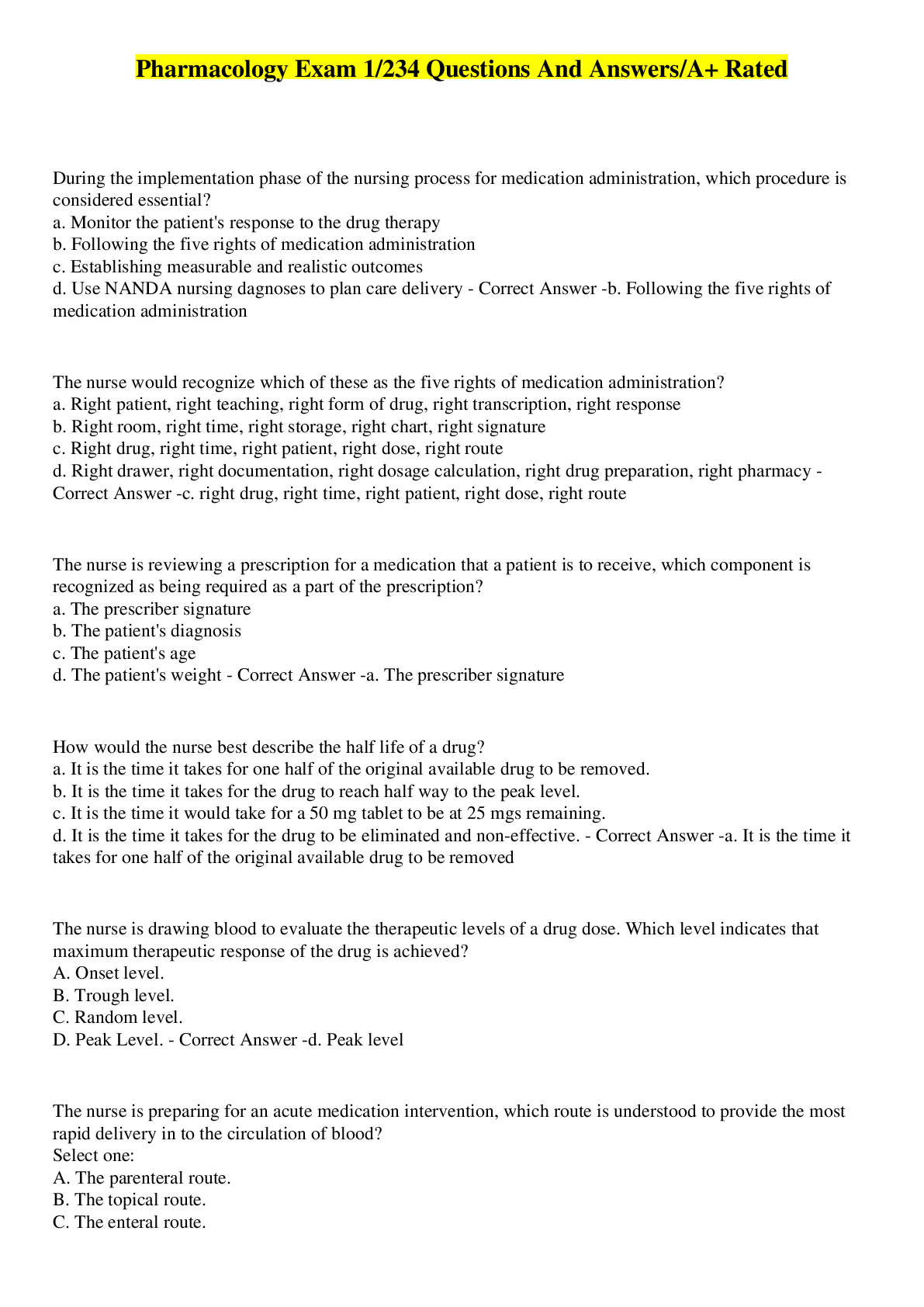*NURSING > EXAM > NR511 / NR 511: Differential Diagnosis & Primary Care Practicum Final Exam .: Chamberlain College Of (All)
NR511 / NR 511: Differential Diagnosis & Primary Care Practicum Final Exam .: Chamberlain College Of Nursing
Document Content and Description Below
NR-511 Differential Diagnosis & Primary Care Practicum Final exam 1. Which of the following information is essential before prescribing Bactrim DS to a 24-year-old woman with urinary tract infec... tion? a. last menstrual period b. method of birth control c. last unprotected sexual contact d. all of the above 2. A 22-year-old male is seen in the clinic because he found a hard lump in his testicle during a testicular self-exam (TSE). which of the following should be included in the differential diagnosis. a. testicular cancer b. inguinal hernia c. varicocele d. all of the above 3. Which of the following dietary information should be given to a patient with gastroesophageal reflux disease (GERD)? a. eliminate coffee b. drink peppermint ice to relieve stomach distress c. recline and rest after meal d. limit the amount of antacids 4. Which of the following are predisposing factors for pyelonephritis? a. pregnancy d. dehydration c. smoking d. alkaline urine 5. A patient is seen in the clinic with right upper quadrant pain (RUQ) that is radiating to the middle of the back. The clinical suspects acute cholelithiasis. The clinician should expect with of the following laboratory findings? a. Decreased alanine aminotransferase (ALT) and aspartate aminotransferase (AST) b. elevated alkaline phosphatase c. elevated indirect biliruben d. decreased white blood cell (WBC) count 6. A 25-year-old patient presents to the clinic with fatigue, cold intolerance, weight gain and constipation for the past 3 months. On physical exam, the clinician notices a sinus bradycardia, muscular stiffness, coarse dry hair and a delay in relaxation in deep tendon reflexes (DTR's). Which of the following tests should be ordered next? a. Serum Calcium b. Thyroid Stimulating Hormone (TSH) c. electrolytes d. urine specific gravity 7. You are preforming muscle strength testing on a patient presenting with musculoskeletal pain and find that the patient has complete range of motion with gravity eliminated. Which numeric grade of muscle strength would you give this patient? a. 1 b. 2 c. 3 d. 4 8. The patient is diagnosed with overactive bladder (OAB). Which of the following instructions should be given to this woman? a. Limit the amount of water that you drink b. eliminate caffeine from your diet c. wear panty liners d. all of the above 9. A 28-year-old patient is seen in the office with colicky abdominal pain, particularly with meals. She has frequent constipation, flatulence and abdominal distention. Which of the data makes a diagnosis of diverticulitis unlikely? a. her age b. frequent constipation c. flatulence d. colicky abdominal pain 10. Treatment for epididymitis includes which of the following? a. warm sitz baths b. scrotal elevation c. masturbation d. all of the above 11. Josh, aged 22, has tinea versicolor. Which description is the most likely for this condition? a. there are round hypopigmented macules on his back b. there are red papules on his face c. there are crusted plaques in Josh's groin area d. there are white streaks on his neck 12. The clinician has instructed Sam, a 25-year-old patient with low back strain, to use NSAID's to manage his symptoms of pain and discomfort. Which of the following statements would be most appropriate within teaching Sam about the use of NSAID' to manage his pain a. you should start with the lowest dose that is effective in managing your pain because long term use of NSAIDS can result in gastrointestinal (GI) disorders such as ulcers and hemorrhage b. you should start with the lowest dose that is effective in managing your pain in order to avoid developing tolerance to the medication c. you should take the maximum recommended dose of NSAID's so that you will not need to take narcotics to control your pain 13. Which of the following patients are at risk for developing urinary tract cancer? a. the 45-year-old woman who is 100 pounds overweight b. the 78-year-old man who smokes three packs of cigarettes a day c. the 84-year-old man who worked in the asbestos mines d. all of the above 14. SNAPPS pneumonic used to describe a technique in orally presenting a patient. A. true b. false 15. The clinician is caring for Diane, a 22-year-old woman who presents with an injured ankle. Diane asks if she will need an x-ray. The clinician explains to Diane that an x-ray is not always necessary for an injured ankle and that the decision to obtain radiography is dependent on the exam and Diane's description of the injury. Which of the following clues in Diane exam or history would alert the clinician to the need for obtaining radiographs a. if she was not able to bear weight immediately after the injury b. if the ankle developed marked swelling and discoloration after the injury c. if crepitation occurs with palpation or movement of the ankle d. all of the above 16. A patient is seen with a sudden onset of flank pain accompanied by nausea, vomiting and diaphoresis. In addition to nephrolithiasis, which of the following should be added to the list of differential diagnosis a. Pancreatitis' b. peptic ulcer disease c. diverticulitis d all of the above 17. Acute angle-closure glaucoma involves a sudden severe rise in intraocular pressure. Which of the following ranges represents normal intraocular pressure a. 0 to 7 mmHg b 8 to 21 mmHg c. 22 to 40 mmHg d. 40-80mmHg 18. A 28-year-old patient is seen with complaints of diarrhea. Which of the following questions would help the clinician establish the diagnosis of irritable bowel syndrome? a. Feels relief after a bowel movement b. sometimes is constipated c. does not defecate in the middle of the night d. all of the above 19. The presence of hairy leukoplakia in a person with no other symptoms of immune suppression is strongly suggestive of which type of infection? a. HSV Type 2 b HIV c Pneumonia d. Syphilis 20. Mrs. Gary is a 55-year-old woman who presents with tightness, pain and limited movement in her right shoulder. She denies any history of trauma. Her exam reveals a 75% reduction in both active and passive range of motion of the right shoulder. Mrs. Gray is also experiencing tenderness with motion and pain at the deltoid insertion. HEr medical history is significant for type 1 DMm and HTN. HEr social history reveals that she is a secretary ant that she is right-handed. Based on her exam and medical history, you suspect adhesive capulitis or "frozen shoulder" Which clue in Mrs. Grays history supports the diagnosis? a. history of hypertension b. her affected shoulder is also her dominant hand c. her history of diabetes 21. A 63-year-old man is seen in the clinic with a chief complaint of nocturia. Which of the following should be included in the differential diagnosis? a. Psychogenic nocturia b. Urethral polyp c. Irritative posterior urethral lesion d. Benign prostatic hypertrophy 22. Joyce is seen in the clinic complaining of vague symptoms of feeling nervous and irritable, and that her hair will not hold a curl anymore. On physical exam, the clinician finds an irregular heartbeat and brisk reflexes. The differential diagnosis could be which of the following? • Myxedema • Cushing's Syndrome • Pan-hypopituitism • Thyrotoxicosis 23. As diabetic retinopathy progresses, the presence of "cotton wool" spots can be detected. Cotton wool spots refer to: a) Venous beading. b) Retinal hemorrhage. c) Nerve fiber layer infarctions. d) Blood vessel proliferation 24. Which of the following instructions should be given to a patient with nephrolithiasis? a. take ibuprofen 600mg every 8 hours b. take tums for upset stomach c. drink more black tea d. increase intake of vegetables like spinach 25. Joyce is taking a long-acting beta agonist for her moderate persistent asthma. What additional medication should she be taking? a. Inhaled corticosteroid (Flovent) b. Leukotriene receptor antagonist c. Systemic corticosteroid (Prednisone) d. Methyl xanthenes (Theophylline 26. You have detected the presence of crepitus on examination of a patient with a musculoskeletal complaint. Additionally, there is limited range of motion (ROM) with both active and passive movement. These findings suggest that the origin of the musculoskeletal complaint is: A. Articular B. Inflammatory C. Non-articular D. A and B 27. Harvey has a rubbery, smooth, round mass on his chest which is compressible and has a soft to very firm texture. What do you diagnose this as? a. Lipoma b. Nevi c. skin tag d. Adenoma 28. The patient with Gastroesophageal reflux disease (GERD) should be instructed to eliminate which of these activities? a. Swimming b. weight lifting c. Golfing d. Walking 29. ...responded to antibiotic therapy. Which of the following actions should be taken next? a. send a urine specimen for microscopy looking for fungal colonies b. increase the dose of the antibiotic c. order a cystoscopy d. order a different antibiotic 30. Cydney was just diagnosed with mild, intermittent asthma. Which if the most appropriate medication for her? a. short acting beta-agonist as needed b. short acting beta-agonist twice a day c. long acting beta agonist as needed d. long acting beta agonist twice a day 31. A patient is seen in the clinic with hematuria confirmed on microscopic examination. The clinician should inquire about the ingestion of which of these substances that may cause hematuria a. NSAIDS b. Beets c. Vitamin A d. Red meat 32. What is the most common cause of anemia a. anemia of chronic disease b. sideroblastic anemia c. iron deficiency anemia 33. The clinical suspects that a client has patellar instability. In order to test for this, the client is seated with the quadriceps relaxed and the knee is placed in extension. Next the patella is displaced laterally and the knee flexed to 30 degrees. IF instability is present, this maneuver displaces the patella to an abnormal position on the lateral femoral condyle, and the client will perceive pain. Testing for patellar instability in this way is known as: a. apprehension sign b. bulge sign c. thumb sign d. none of the above 34. If your preceptor is out ill on a day that you are scheduled to be in the clinical setting, another preceptor can supervise you as long as they are willing to take you on as a student and they meet the minimum preceptor qualifications. a. true a. false 35. Which of the following should be considered in a patient presenting with erectile dysfunction a. diabetes mellitus b. hypertension c. atherosclerosis d. all of the above 36. A 23-year-old sexually active man is seen in the clinic with unilateral painful testicular swelling and diagnosed with epididymitis. In order to prescribe the correct drub, the clinician understands that which of these is the most common causative organism? a. Escherichia coli b. staphylococcus aureus c. chlamydia trachomatis d. pseudomonas aeruginosa 37. The most common offending agents for medication induces resting tremor are: a. selective serotonin reuptake inhibitor (SSRIs) b. Beta-Blockers c. Fluroquinolone antibiotics d. anti-psychotics 38. Which of the following type of tremor is characterized by an increase in amplitude when the patient attempts voluntary movements a. resting tremor b. postural tremor c. intention tremor d. medication-induced tremor 39. Ian, age 62, presents with a wide, diffuse area of erythematous skin on his left lower leg that is warm and tender to palpation. There is some edema involved. You suspect: a. Necrotizing fasciitis. b. Kaposi's sarcoma. c. Cellulitis. d. A diabetic ulcer. 40. Parkinson’s disease is a progressive neurological disorder that is associated with which type of tremor? a. resting tremor b. postural tremor c. intention tremor d. medication induced tremor 41. Which information should be included when you are teaching your patient about the use of nicotine gum? a. the gum must be correctly chewed to a softened state then placed in the buccal mucosa b. patients should not eat for 30 minutes prior to or during the use of the gum c. initially, one piece is chewed every 30 minutes while awake d. acidic foods and beverages should be encouraged during nicotine therapy 42. Severe pain associated with acute otitis media signifies perforation of the tympanic membrane. a. true b. false 43. Jason, aged 62, has obstructive sleep apnea. What do you think is one of his contributing factors? a. He is a recovering alcoholic of 6 years. b. His collar size is 19 inches. c. He is the only person in his family who has this. d. He is extremely thin. 44. The "B" in the ABCDEs of assessing skin cancer represents: a. biopsy b. best practice c. boundary d. border irregularity 45. The patient is diagnosed with urge incontinence. Before prescribing Detrol XL, the provider should question the patient about which of these contraindications to this medication? a. diarrhea b. Parkinson's disease c. closed-angle Glaucoma d. Breast cancer 46. A patient is diagnosed with hypothyroidism. Which of the following electrocardiogram (ECG) changes should the clinician expect as a manifestation of the disease? a. sinus bradycardia b. atrial fibrillation c. supraventricular tachycardia d. U-waves 47. Tori is on systematic antifungals for a bad tinea infection. You understand that serum labs should be monitored for: a. renal failure b. hepatotoxicity c. electrolyte imbalance d. leukocytosis 48. Which of the following signs or symptoms indicate an inflammatory etiology to musculoskeletal pain? a. decreased C-reactive protein b. hyperalbuminemia c. morning stiffness 49. A 22-year-old is seen complaining of vague belly pain. This type of pain is seen at what point in appendicitis? a. very early b 3-4 hours after perforation c. late in inflammation d. appendicitis never presents with vague pain 50. A patient presents to the clinician’s office with a sore throat, fever of 100.7 and tender anterior cervical lymphadenopathy. The clinician suspects strep throat and performs a rapid strep test that is negative. What would the next step be? a. the patient should be instructed to rest and increase fluid intake as the infection is most likely viral and resolve without antibiotic therapy b. because the patient does not have strep throat, the clinician should start broad spectrum antibiotics in order to cover the offending pathogen c. a throat culture should be performed to confirm the results of the rapid strep test 51. Which of the following statements is true regarding the treatment of carpel tunnel syndrome? a. the goal of treatment is to prevent flexion and extension movements of the wrist b. splints are used in carpal tunnel syndrome because the allow for free movement of the fingers and thumb while maintaining the wrist in a neutral position c. corticosteroid injections are discouraged in the treatment of carpal tunnel syndrome because of the risks for median nerve damage, scarring and infection d all of the above 52. Which statement about HIV post-exposure prophylaxis (PEP) for healthcare workers is most accurate? a. PEP should be started within hours after the exposure b. PEP should be started within 73 hours after the exposure c. Renal and hepatic function tests should be done 6 weeks after beginning PEP d. PEP will prevent potential hepatitis-C infection if present 53. Sinusitis is considered when there are episodes of prolonged inflammation with repeated or inadequately treated acute infection lasting greater than: a. 4 weeks b. 8 weeks c. 12 weeks d. 16 weeks 54. A patient presents with the following signs and symptoms: gradual onset of low-grade fever, marked fatigue, severe sore throat and posterior cervical lymphadenopathy. Based on the signs and symptoms alone, which of the following conditions is most likely the cause? a. gonorrhea b. mononucleosis c. influenza d. herpes zoster 55. In which of the following situations would referral to a specialist be needed for sinusitis a. recurrent sinusitis b. allergic sinusitis c. sinusitis that is refractory to antibiotic therapy d. all of the above 56. Heart valve damage resulting from acute rheumatic fever is a long-term sequela resulting from infection with which of the following pathogens? a. coxsackievirus b. cytomegalovirus c. francisella tularensis d. group A streptococcus 57. What is the recommended calcium intake for adults over the age of 50 with low bone mass? a. 1200mg/day b 1000mg/day c. 1300mg/day d. 1500mg/day 58. A 14-year-old is seen with complaints of severe testicular pain. The clinician suspects testicular torsion. Which of the following is the appropriate action? a. obtain a scrotal ultrasound b. obtain a computed tomography scan (CT) c. instruct the patient to elevate the scrotum d. send the patient to the Emergency room 59. All students are subject to review of clinical logs to ensure that they have received a well-rounded experience a. true b. false 60. A 30-year-old patient presents with pain on urination. The urine microscopy of unspun urine showed greater than 10 leukocytes/ml and a dipstick was possible for nitrates. What is the probable diagnosis? a. lower urinary tract infection b. chlamydia infection c. candidiasis d. pyelonephritis 61. Fluctuations and reductions in estrogen may be a contributing factor in which type of rhinitis? a. vasomotor rhinitis b. rhinitis medicamentosum c. atophic rhinitis d. viral rhinitis 62. John is a 16-year-old boy who presents to the emergency room after hurting his knee in a football game. He described twisting his knee and then being unable to extend it completely. John tells the clinician that he heard a pop when the injury occurred and has been experiencing localized pain. The clinician suspects a meniscal tear. Which test would be most appropriate to assess for the presence of a meniscal tear? a. valgus stress test b. McMurray circumduction test c. Lachman's test d. Varus stress test 63. Your patient has decided to give Chantix a try to quit smoking. You are discussing his quit date, and he will begin taking the medication starting tomorrow. When should he plan to quit smoking? a. he should stop smoking today b. he should stop smoking tomorrow c. his quit date should be in one week d. he will be ready to quit after the first 30 days 64. The patient is prescribed radioactive iodine (RAI) and asks the clinician how this drug works. The clinician’s response should include which of the following data? a. RAI prevents the peripheral conversion of T4 to T3 b. RAI binds to free T4 c. RAI destroys thyroid tissue d. RAI reduces freely circulating iodine 65. Not sure of the question...something about the oral mucosa membranes********** a. vincents stomatitis b. allergic stomatitis c. apthous stomatitis d. herpetic stomatitis 66. Janet is a 30-year-old woman who has been recently diagnosed with a herniated disc at the level of L5-S1. She is currently in the emergency room with suspicion of cauda equna compression. Which of the following is a sign or symptom of cauda equina compression? a. gastrocnemius weakness b. reduced or absent ankle reflex c. numbness of the lateral foot d. paresthesia of the perineum and buttocks 67. The patient has acute pancreatitis with 7 of the diagnostic criteria from Ranson's Criteria. In order to plan care, the clinician understands that this criteria score has which of the following meanings? a. a high mortality rate b. an increased chance of recurrence c. 7% chance of the disease becoming chronic d. all of the above 68. Reuben, age 24, has HIV and just had a routine viral load test done. The results show a falling viral load What does this indicate a. a favorable diagnostic trend b. disease progression c. the need to be more aggressive with Reuben's medications d. the eradication of the HIV 69. Which is the differentiating symptom between labyrinthitis and vestibular neuritis? a. symptoms with vestibular neuritis are usually acute in onset, whereas with labyrinthitis the onset is more gradual b. hearing loss may be associated with vestibular neuritis, but not with labyrinthitis c. symptoms with labyrinthitis are usually acute in onset, ,whereas with vesticular neuritis the onset is more gradual d. hearing loss may be associated with labyrinthitis ,but not with vestibular neuritis. 70. A 27-year-old female presents with a chief complaint of burning and pain on urination. She has no previous history of urinary tract infection. what are some additional symptoms consistent with a diagnosis of lower UTI? a. back and abdominal pain b. fever, chills, costovertebral angle (CVA) tenderness c. blood in urine and frequency d. foul-smelling discharge, perineal itch 71. The differential diagnosis for vertigo can be classified into which of the following categories: a. peripheral vestibular disease b. CNS disorders c. Systemic disorders d. all of the above 72. Sam is a 25-year-old man who has been diagnosed with low back strain based on his history of localized low back pain and muscle spasm along with a normal neurological examination. As the clinician, you explain to Sam that low back pain is a diagnosis of exclusion. Which of the following symptoms would alert the clinician to the more serious finding of a herniated nucleus pulposus or ruptured disc? a. morning stiffness and limited mobility of the lumbar spine b. unilateral radicular pain symptoms that extend below the knee and are equal to or greater than the back pain c. Fever, chills, and elevated erythrocyte sedimentation rate d. pathologic fractures, severe night pain, weight loss and fatigue 73. Preceptors must always see the patients that the students see in the clinical setting a. true b. false 74. An 82-year-old man is seen in the primary care office with complaints of dribbling urine and difficulty starting his stream. Which of the following should be included in the list of differentials? a. BPH b. Prostate cancer c. UTI d. all of the above 75. Which causes the greatest percentage of mammalian bites? a. dogs b. cats c. humans d. rodents 76. Endoscopic report reveals the presents of Barrett's epithelium. Which of the following information should the clinician include in the explanation of the pathology report? a. this is a premalignant tissue b. this tissue is resistant to gastric acid c. this tissue supports healing of the esophagus d. all of the above 77. Which of the following data are indicative of testicular torsion? a. absent cremasteric reflux b. pain relived on testicular elevation c. testicle very low in the scrotum d. swollen scrotum with a red dot sign 78. Most nosocomial pneumonias are caused by: a. Fungi. b. Viruses c. Gram-negative bacteria. d. Pneumococcal pneumonia. 79. A family practice office for all 5 of your clinical rotations will guarantee that you will gain the required pediatric exposure a. true b. false 80. The most common precancerous skin lesion found in Caucasians is a. skin tags b. actinic keratosis c. melanoma d. basal skin lesion 81. Which obstructive lung disease is classified as reversible? a. Asthma b. Chronic bronchitis c. Emphysema d. COPD 82. Which of the following is an example of an articular structure a. bone b. synovium c. tendons d. fascia 83. Jennifer is an 18-year-old girl who comes to the emergency room after a fall during a soccer game. Jennifer explains that she fell on her left side and kept her arm out straight to break her fall. She has been experiencing severe pain and limited range of motion in her left shoulder. The clinician has diagnosed Jennifer with a dislocated shoulder. Which of the following statements are true concerning shoulder dislocation? a. posterior dislocations are more common than anterior dislocations b. there is a risk of neurovascular and neurosensory trauma, so the clinician should check for distal pulses 84. Which of the following statements is true concerning the management of the client with a herniated disc? a. muscle relaxants and narcotics can be used to control moderate pain but should be discontinued after 3 weeks of use b. an epidural injection is helpful in reducing leg pain that has persisted for at least 3 weeks after the herniation occurred. c. intolerable pain for more than 3 months is an indication for surgical intervention d. all of the above 85. After 6 months of Synthroid therapy, the clinician should expect which of the following in the repeat thyroid studies? a. elevated TSH b. normal TSH c. low TSH d. undetectable TSH 86. The clinician suspects that a client seen in the office has hyperthyroidism. Which of the following tests should the clinician order on the initial visit? a. thyroid stimulating hormone (TSH) and free T4 b. TSH and thyrotoxin antibodies c. High sensitivity thyroid stimulating hormone TSH and free T4 d. Free T4 and serum calcium 87. Cat bites are commonly associated with which of the following pathogens? a. pasteurella multocida b. vibri vulnificus c. group B streptococcus d. Group A beta hemolytic streptococcus 88. The 56-year-old man with chronic prostatitis should be treated with trimethoprim 80mg-sulfamethoxazole 400 (TMP-SMX, Bactrim) for how long? a. 3-7 days b. 14-21 days c. 3-6 weeks d 6-12 weeks 89. The A in SNAPPS stands for Assessment a. true b. false 90. A patient is diagnosed with Giardia after backpacking trip in the mountains. Which of the following would be the appropriate treatment? a. Vancomycin b. Penicillin c. Metronidazole d. Bactrim 91. The most cost-effective screening test to determine HIV status is which of the following? a. western blot b. enzyme-linked immunosorbent assay (ELISA) c. venereal disease research laboratory test (VDRL) d. Viral load 92. The clinician sees a patient who is 5 feet tall and weighs 150 pounds (: BMI 29.3). How would the clinician classify this patient? a. overweight b. Mild Obesity c. Moderate Obesity d. morbid obesity 93. One of the initial steps in assessing patients with musculoskeletal complaints is to determine whether the complaint is articular or non-articular in origin. Which of the following is an example of an articular structure? A. Fascia B. Bone C. Synovium D. Tendons 94. Jennifer is an 18-year-old girl who comes to the emergency room after a fall during a soccer game. Jennifer explains that she fell on her left side and kept her arm out straight to break her fall. She has been experiencing severe pain and limited range of motion in her left shoulder. The clinician has diagnosed Jennifer with a dislocated shoulder. Which of the following statements are true concerning shoulder dislocation? a. posterior dislocations are more common than anterior dislocations b. there is a risk of neurovascular and neurosensory trauma, so the clinician should check for distal pulses 95. Which of the following types of cellulitis is a streptococcal infection of the superficial layers of the skin which does not involve the subcutaneous layers? a. necrotizing fasciitis b. periorbital cellulitis c. erysipelas d. flesh eating bacteria 96. A 76-year-old man is seen in the office for complaints of urinary incontinence. The clinician should suspect which of these causes of incontinence in men? a. urethral polyps b. urinary tract infection (UTI) c. anticholinergic medications d. all of the above 97. Sally, aged 25, presents with impetigo that has been diagnosed as infected with staphylococcus. The clinical presentation is pruritic tender, red vesicles surrounded by erythema with a rash that is ulcerating. She has not been adequately treated recently. Which type of impetigo is this? a. Bullous impetigo b. Staphylococcal scalded skin syndrome (SSSS) c. Nonbullous impetigo d. Ecthyma 98. A 42-year-old woman is seen in the clinic with fever, chills, vomiting and severe dysuria. She is diagnosed with acute pyelonephritis. How should this patient be managed? a. 3-day course of oral antibiotics b. hospitalization 99. Which of the following are risk factors associated with obesity? a. diabetes b. skin infections c. arthritis d. all of the above [Show More]
Last updated: 1 year ago
Preview 1 out of 9 pages
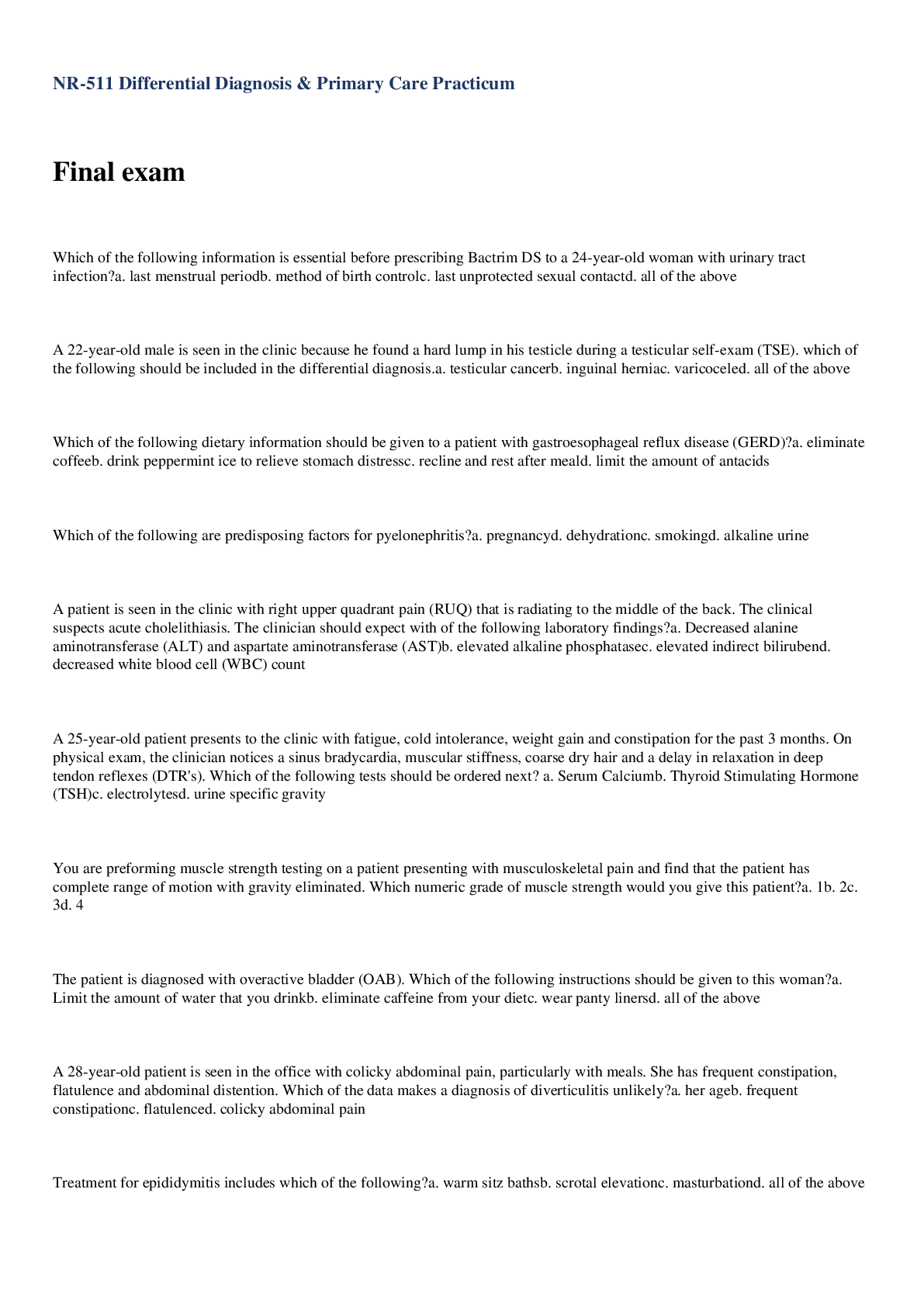
Reviews( 0 )
Document information
Connected school, study & course
About the document
Uploaded On
Nov 14, 2020
Number of pages
9
Written in
Additional information
This document has been written for:
Uploaded
Nov 14, 2020
Downloads
0
Views
31

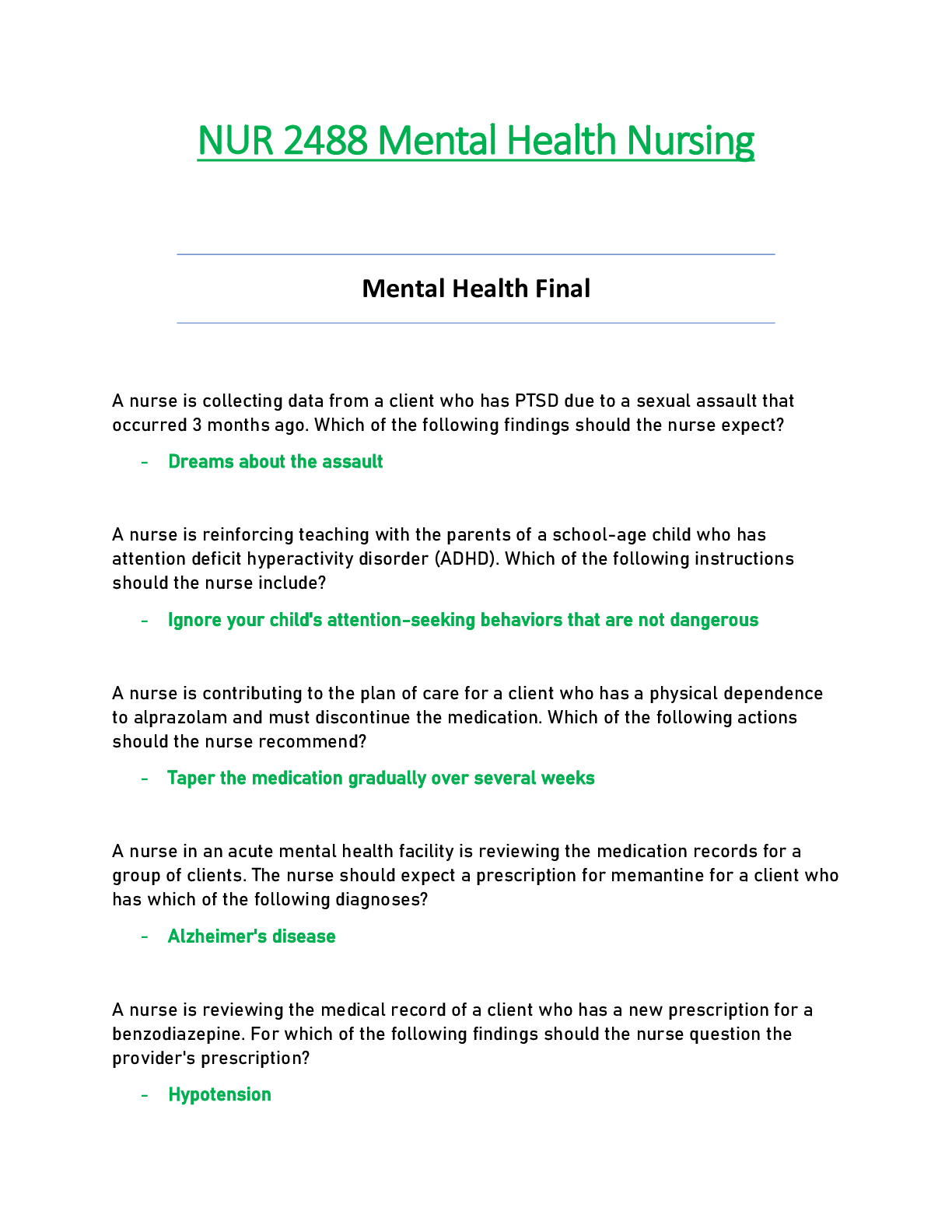
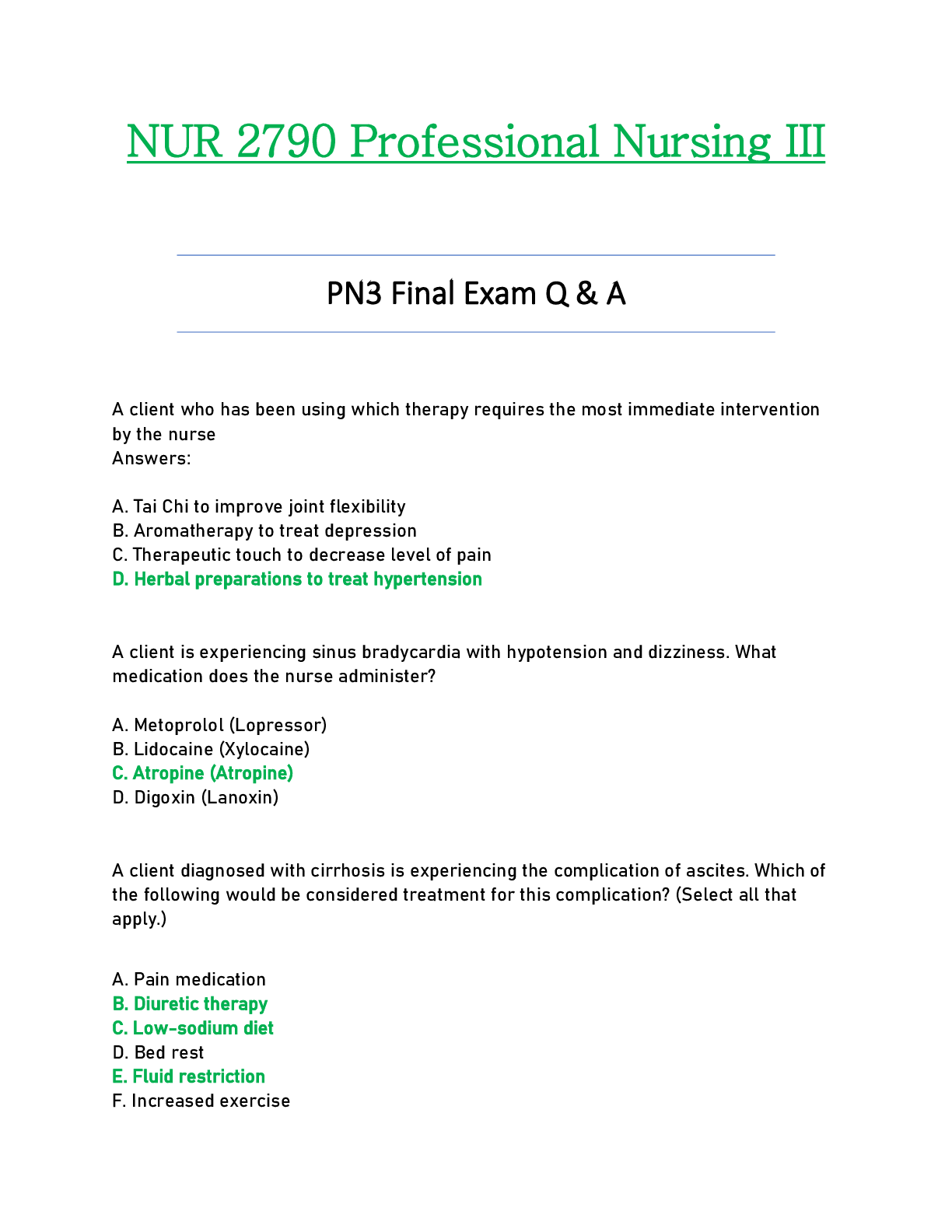
.png)
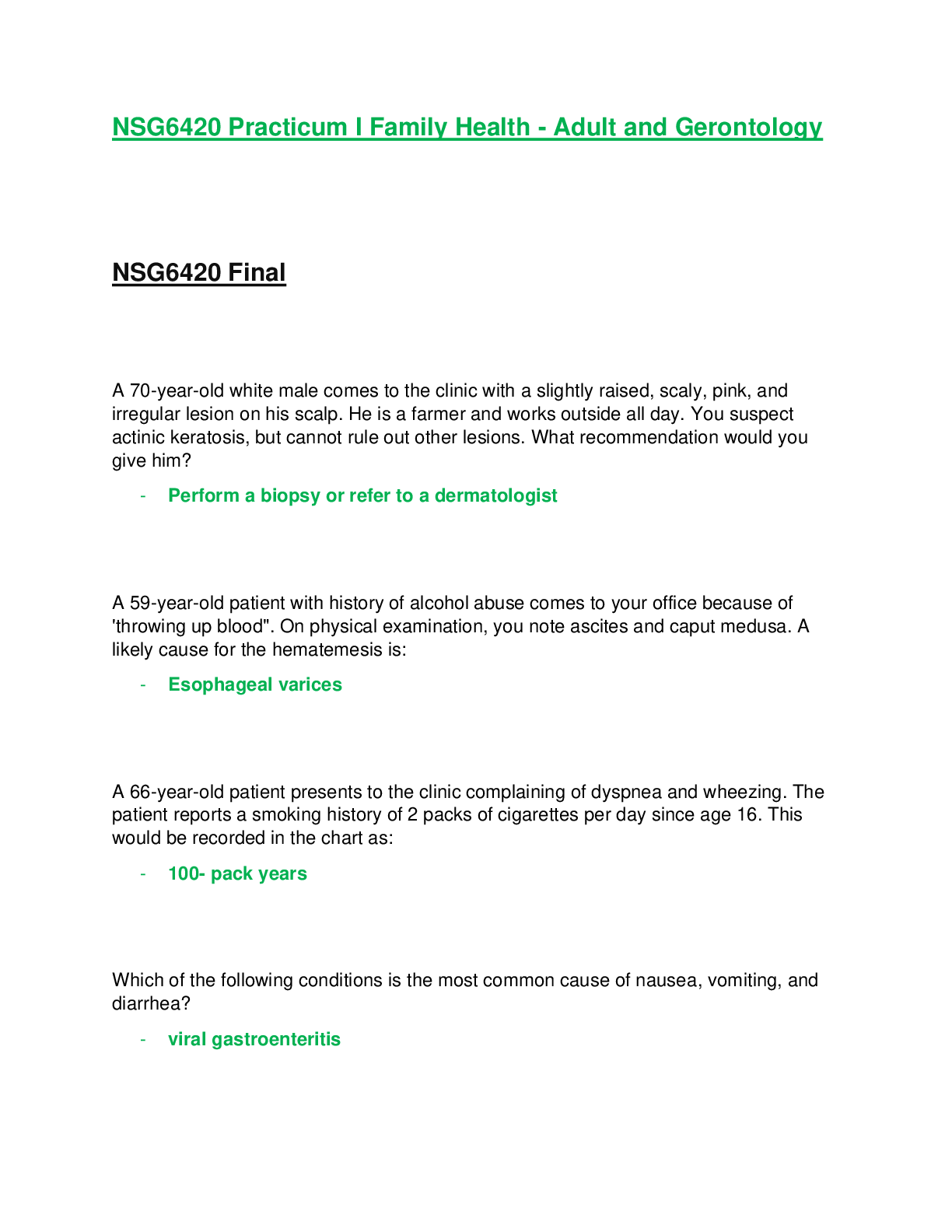
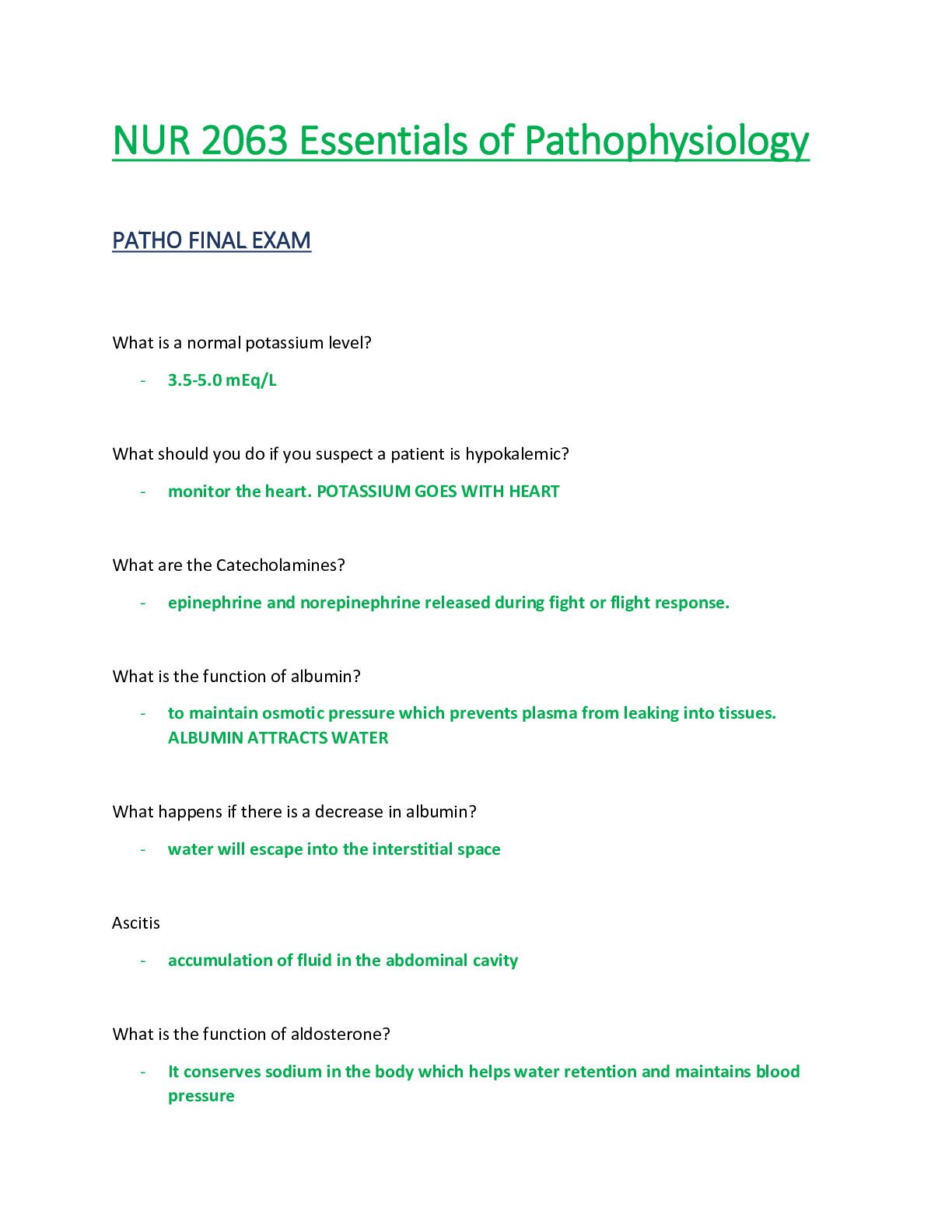

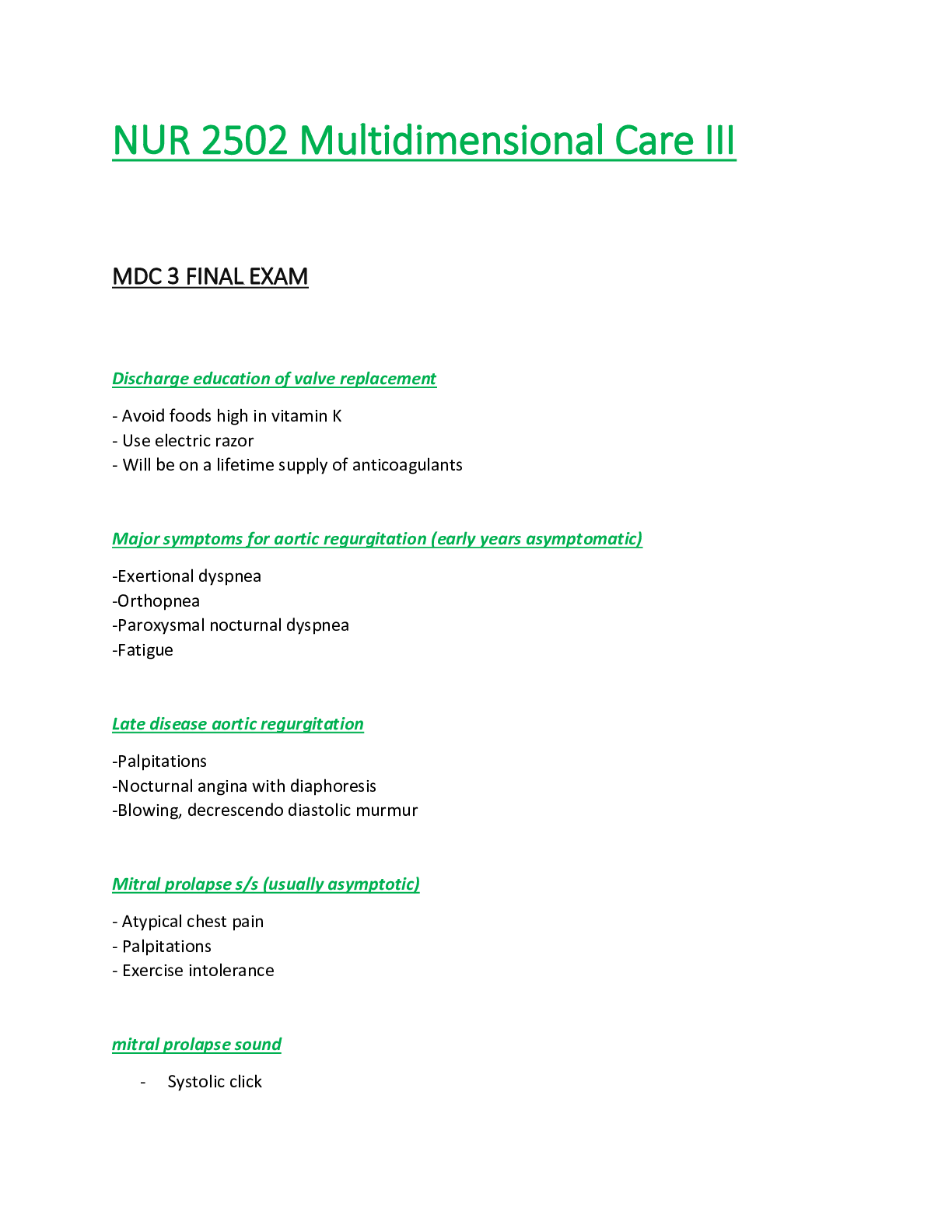
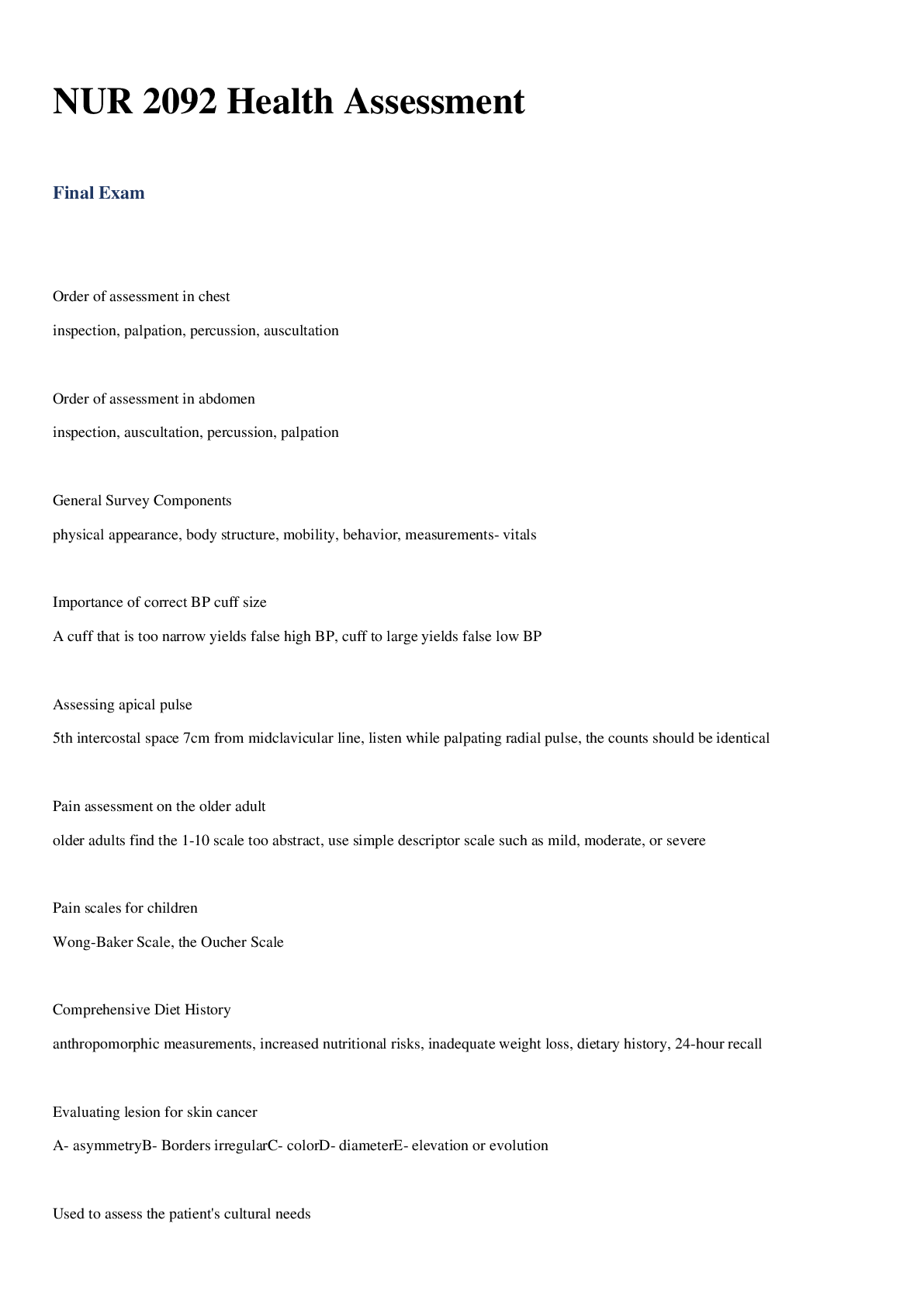
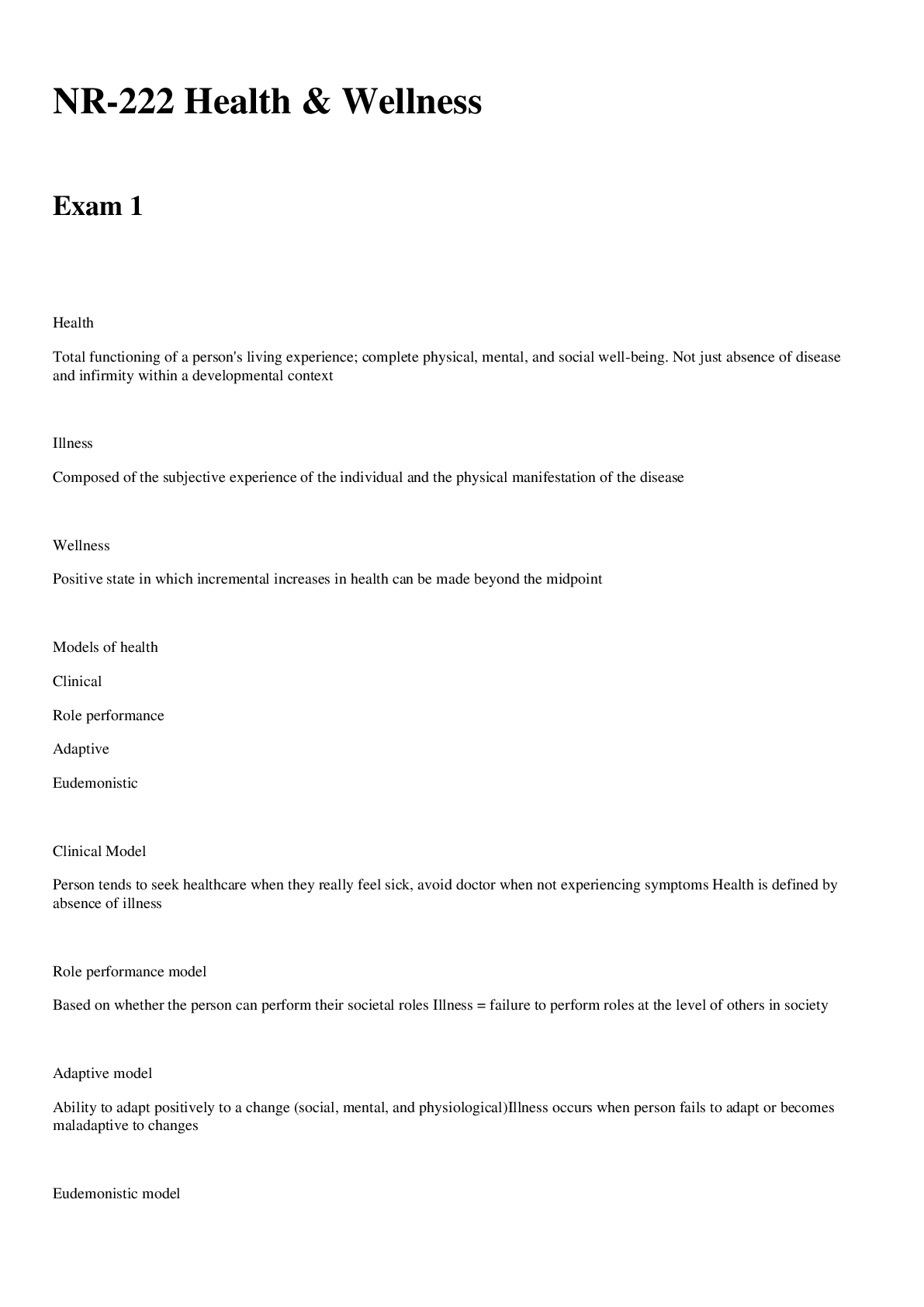
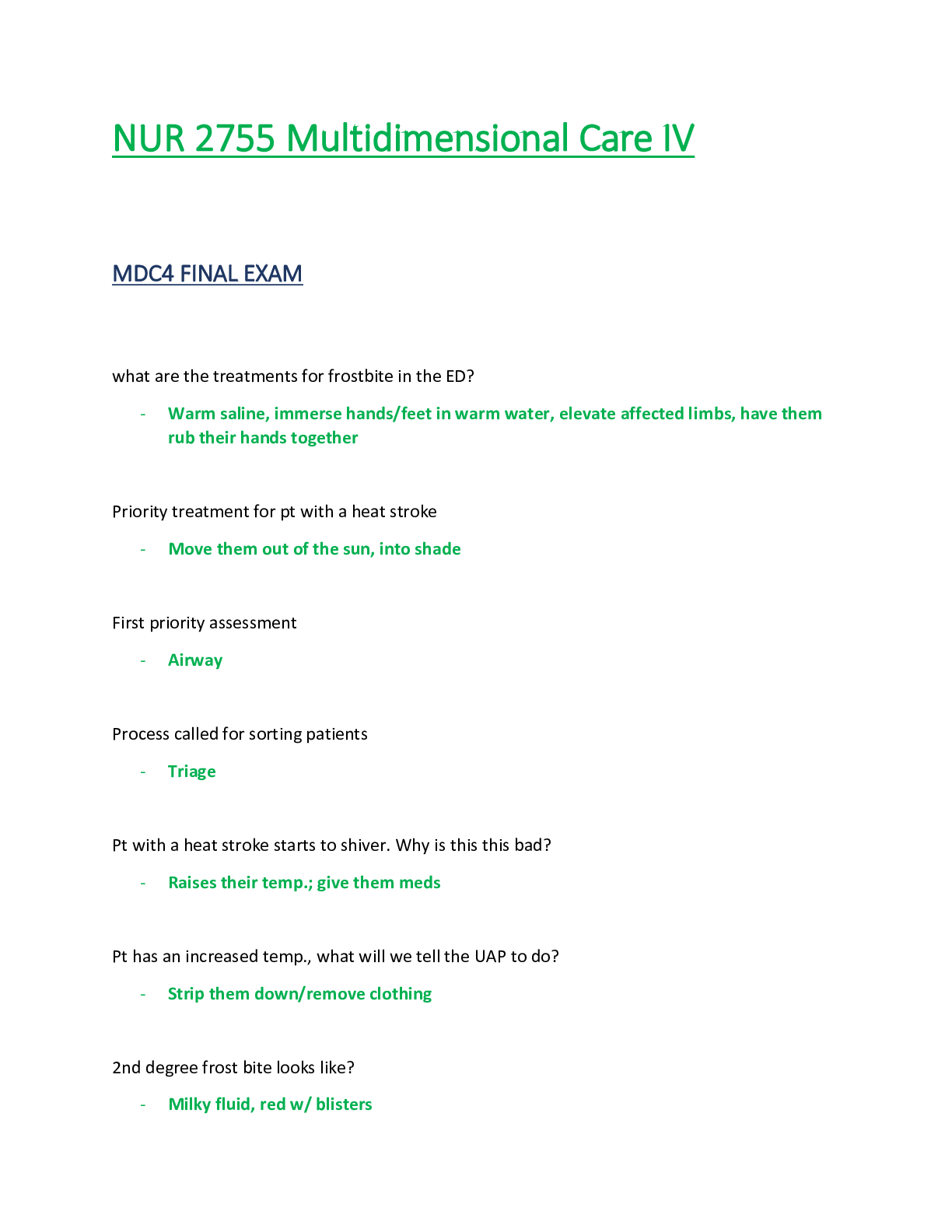
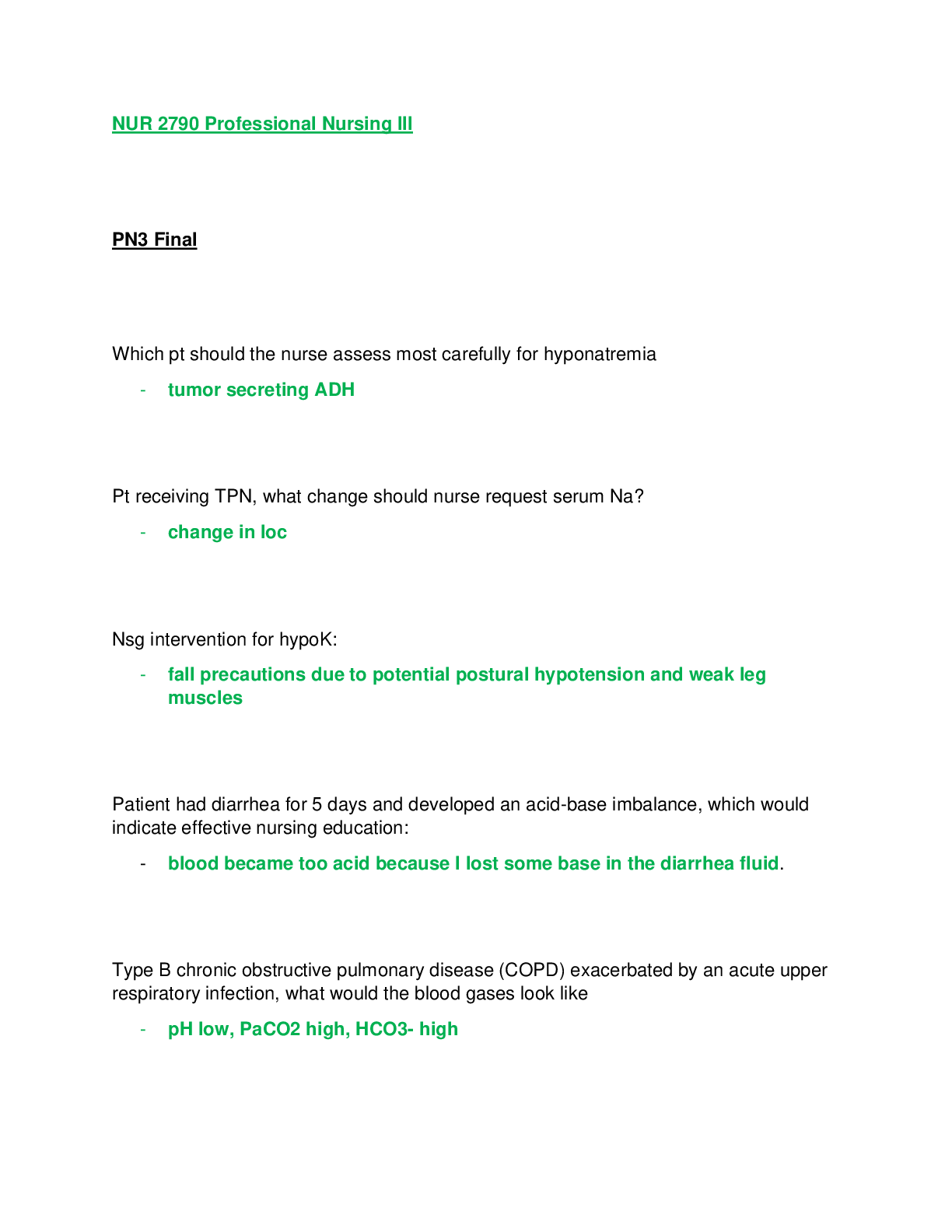
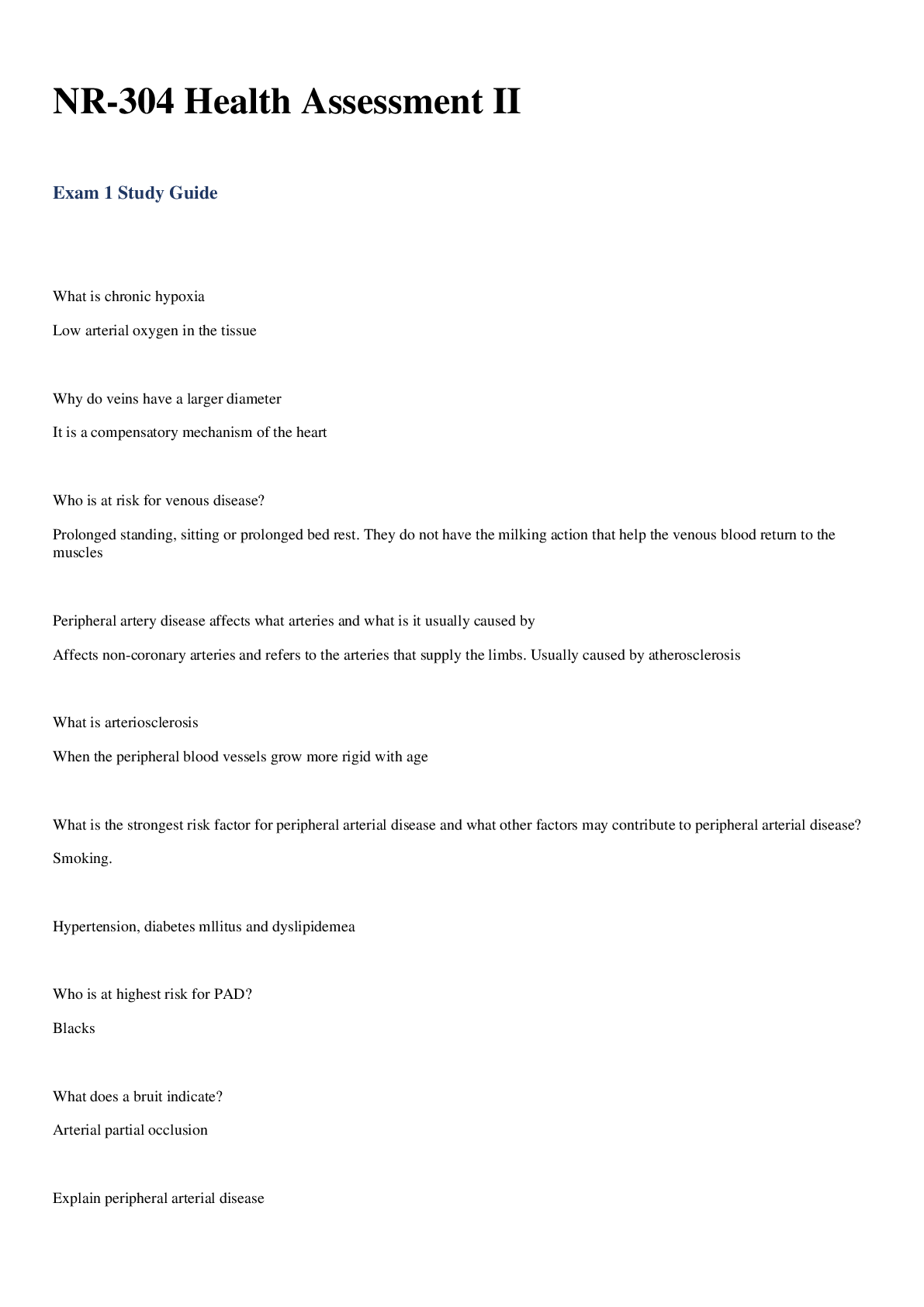

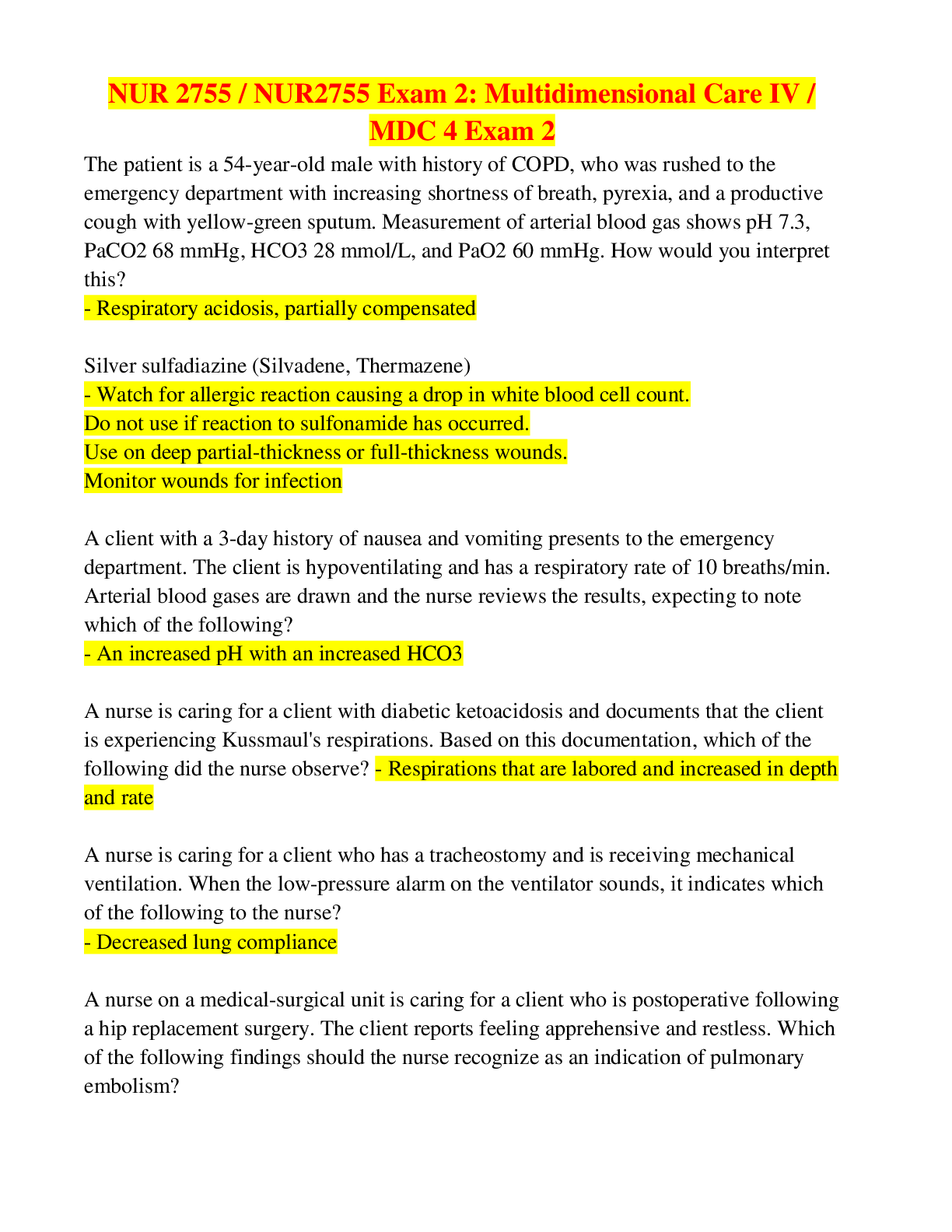
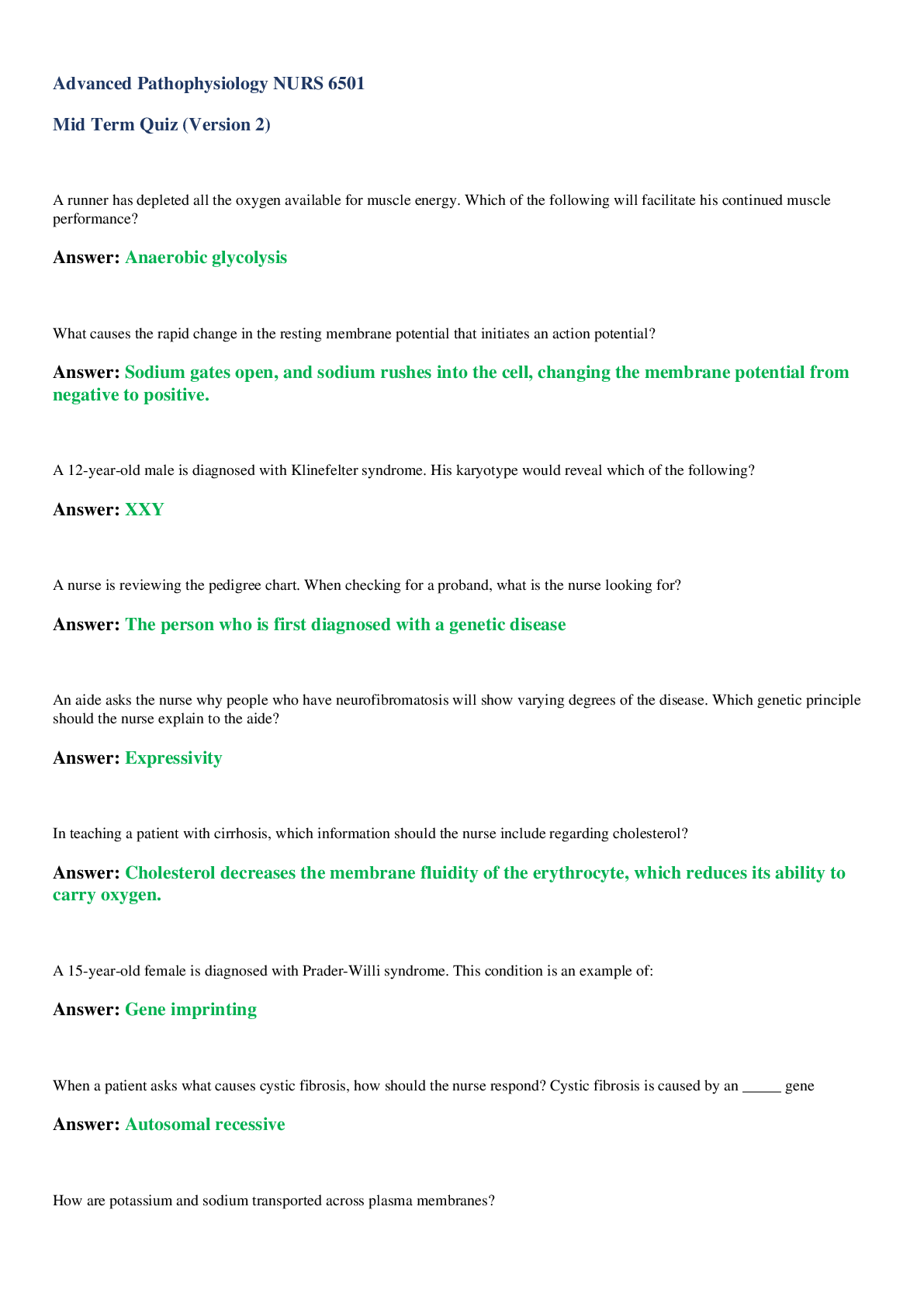
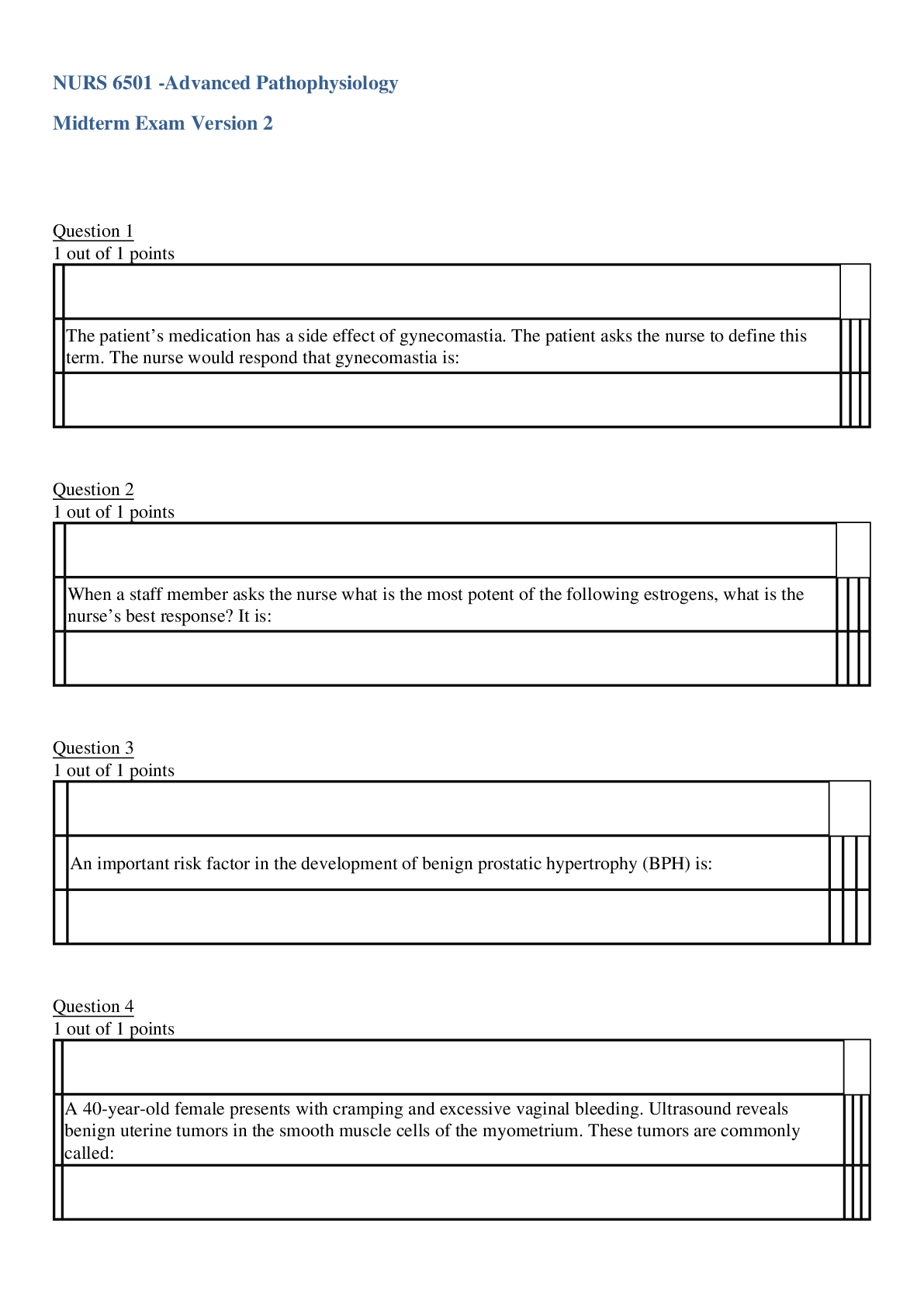
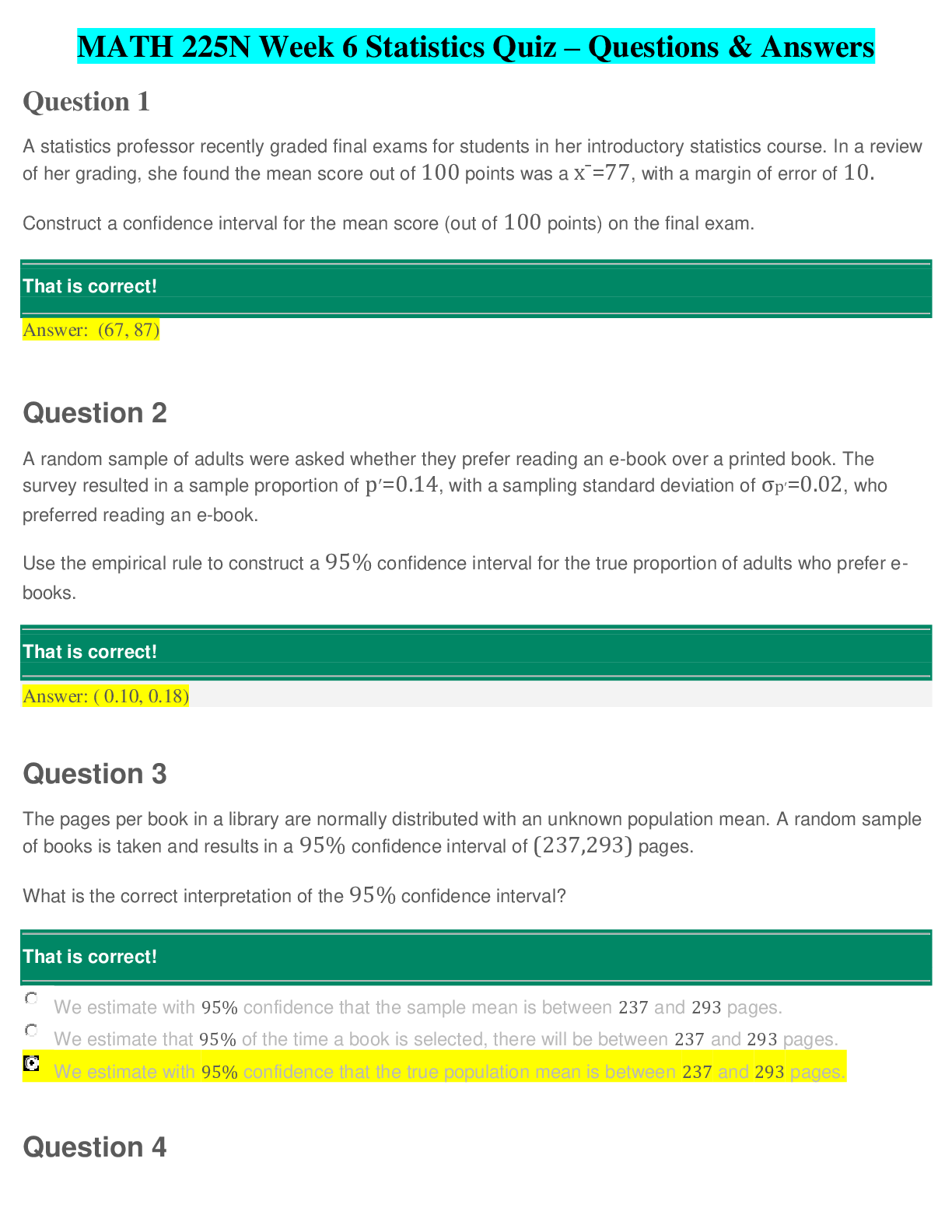

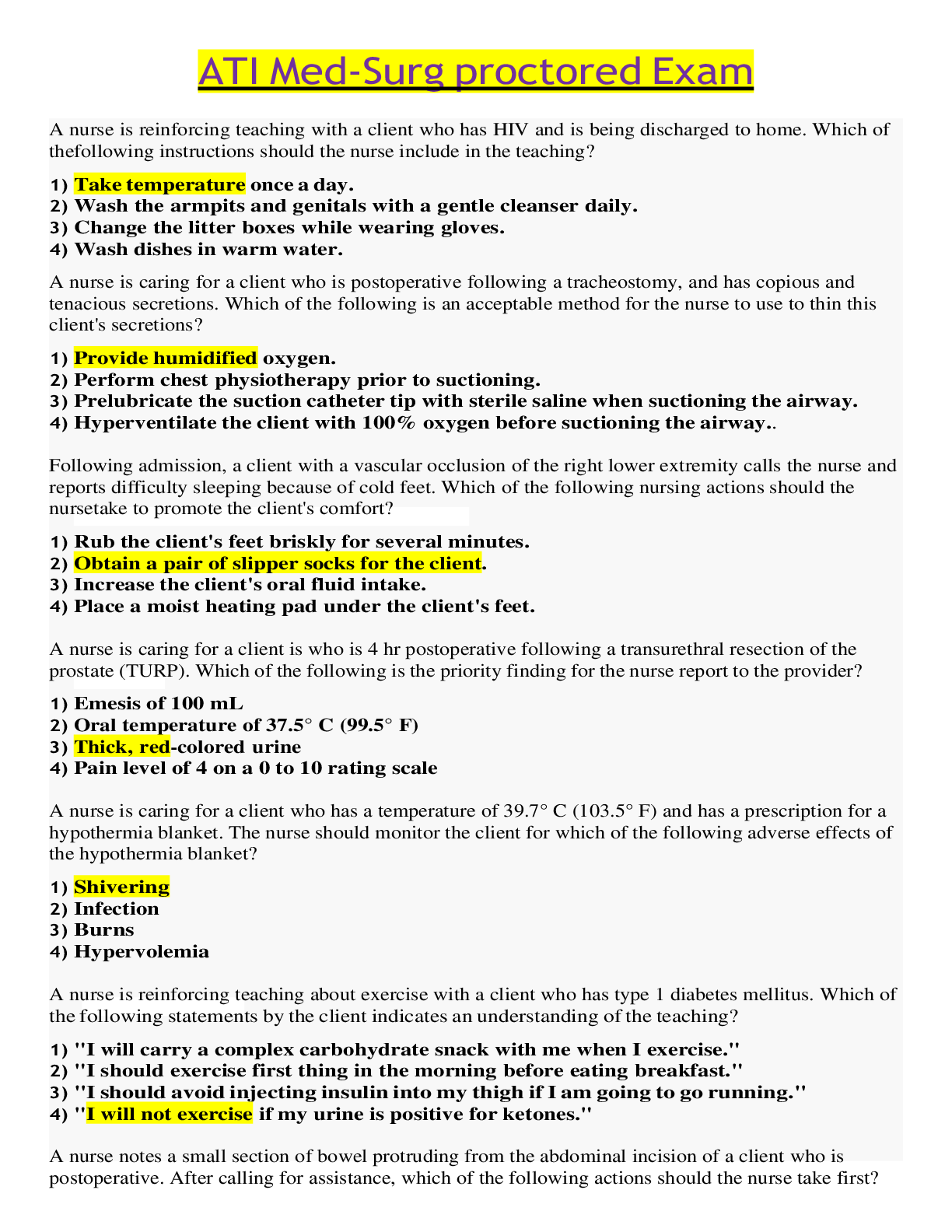
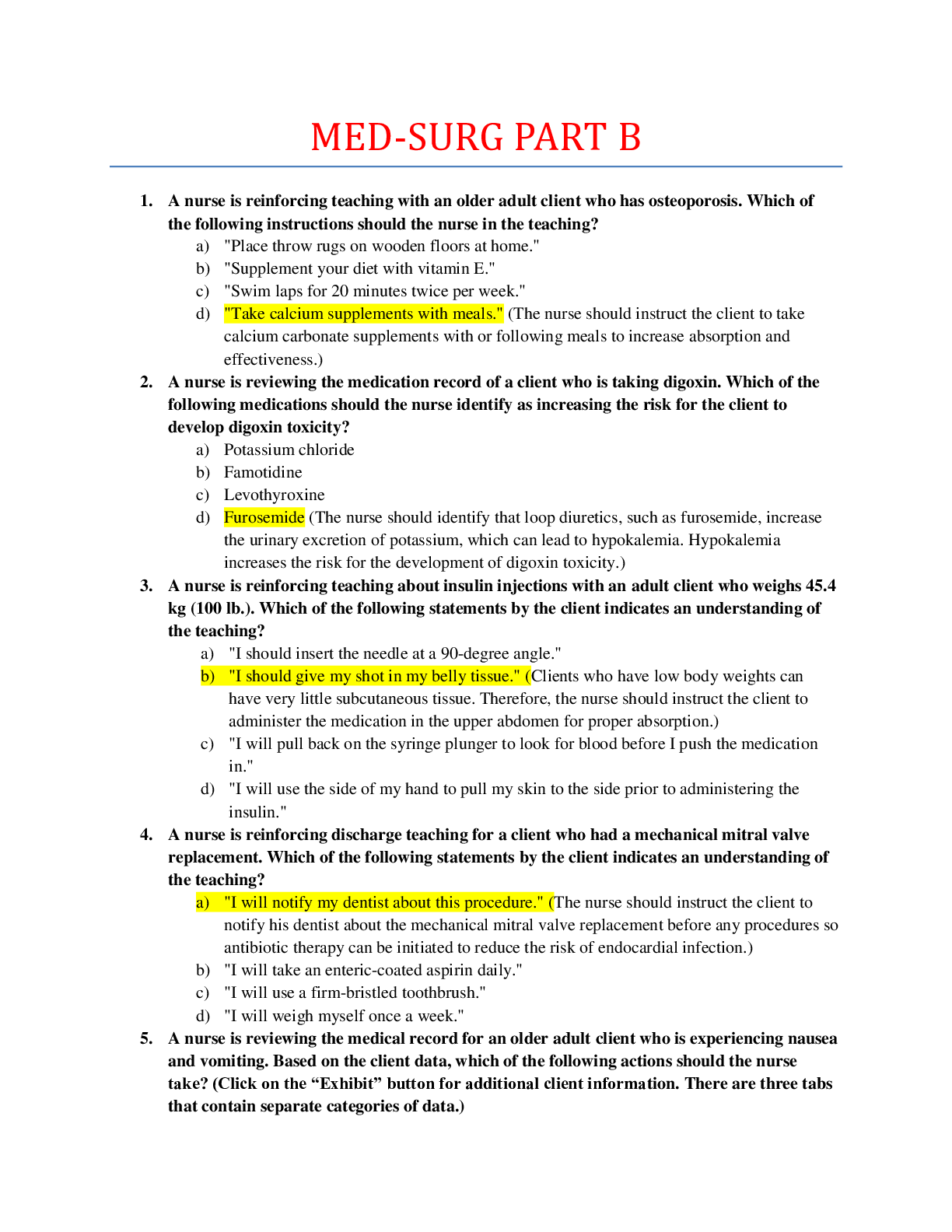
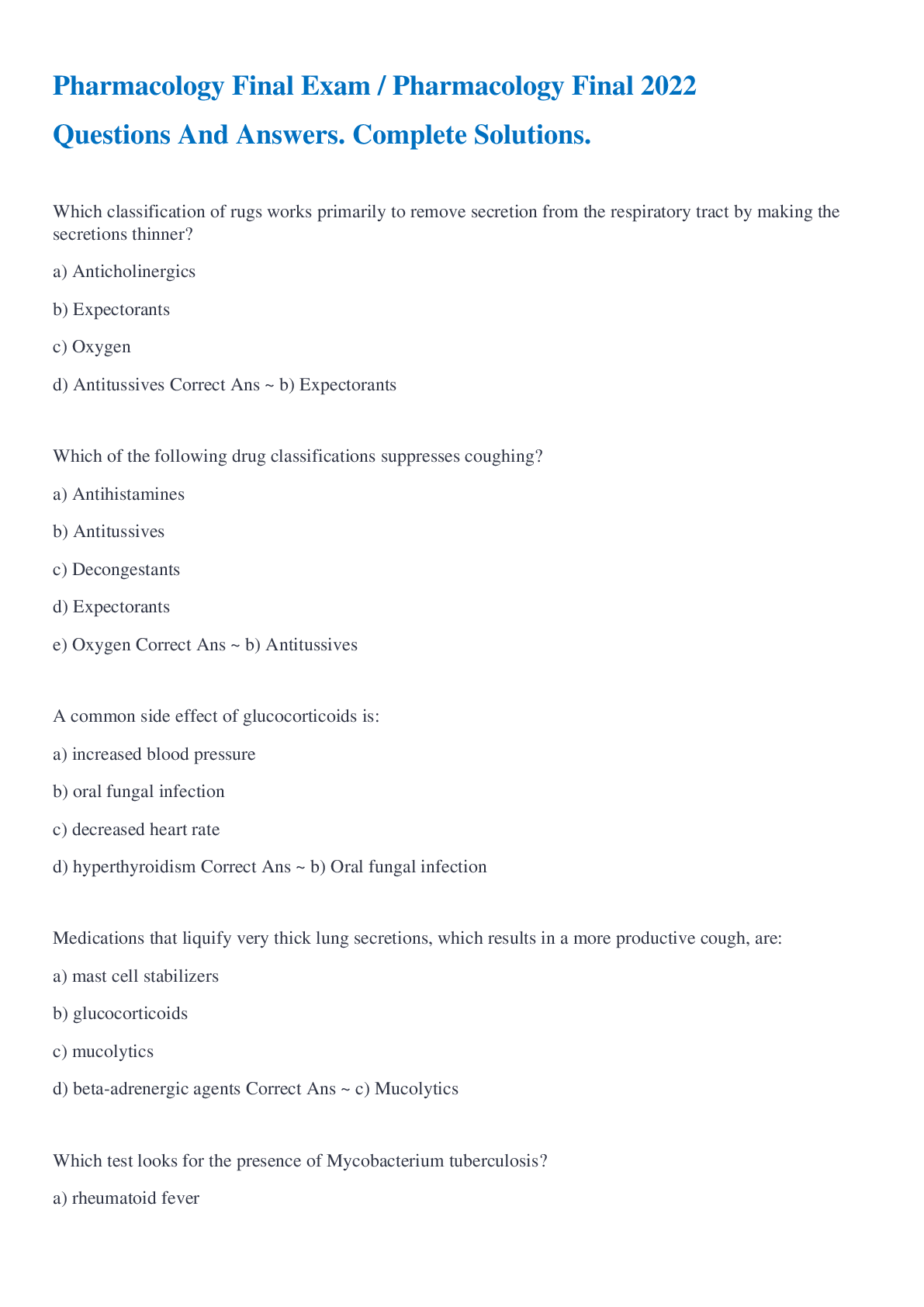
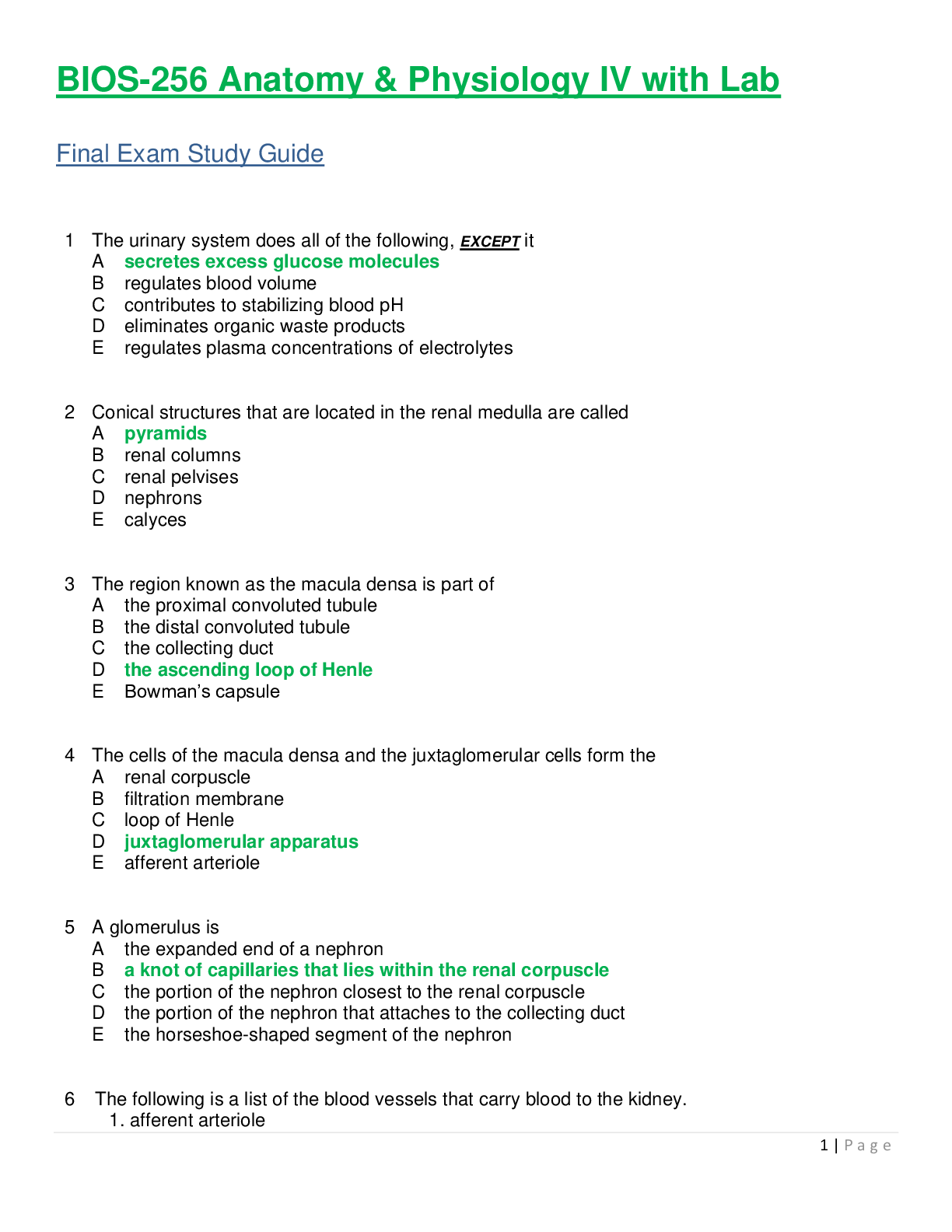
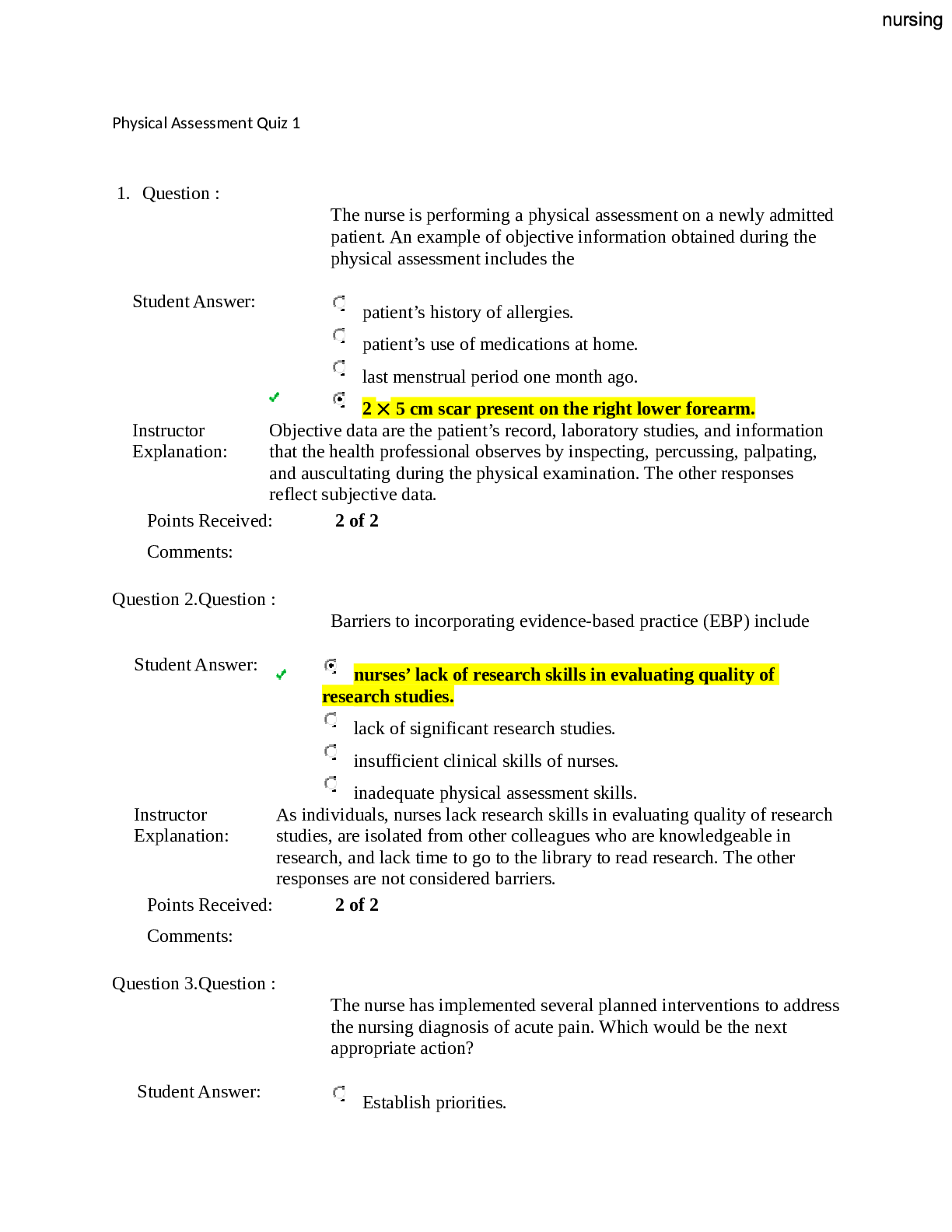

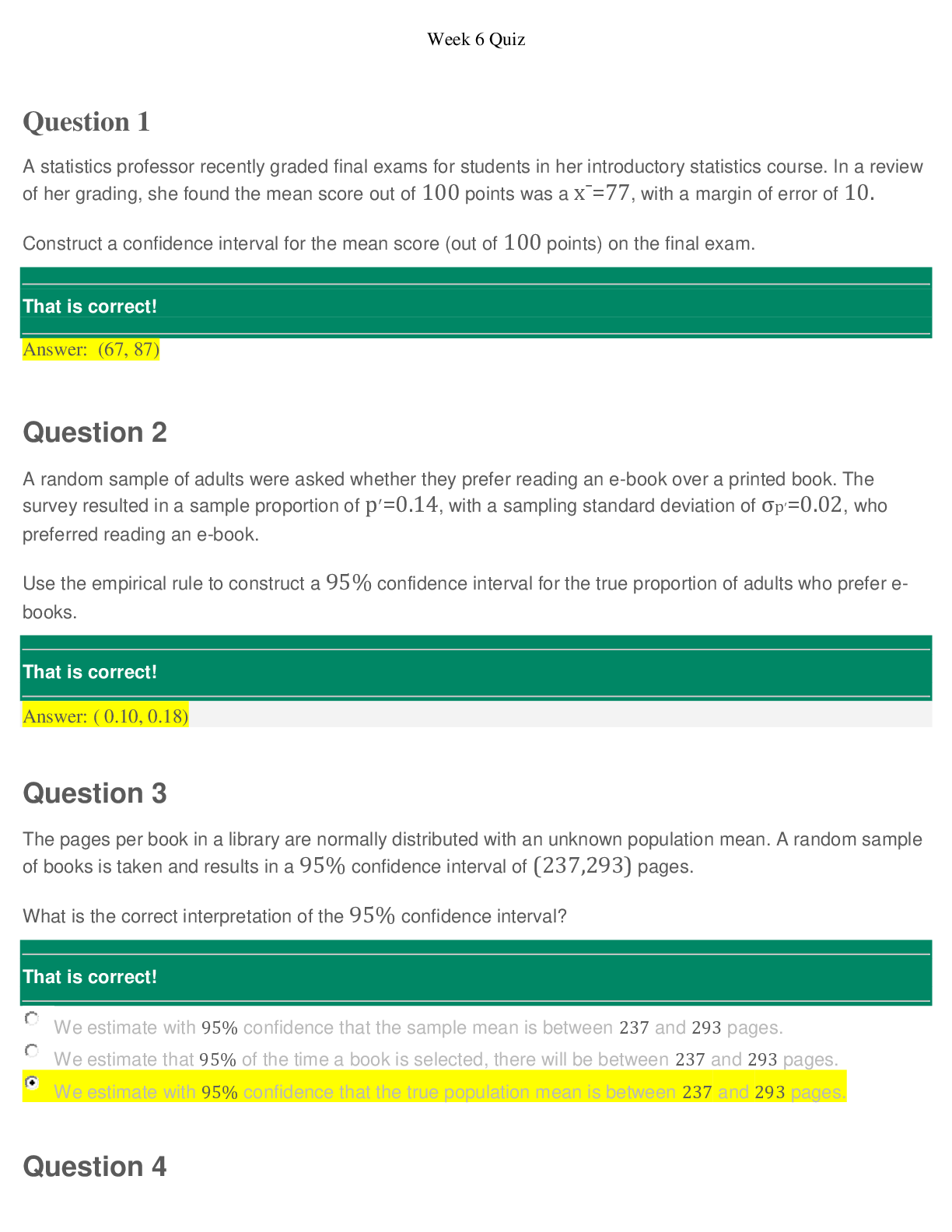
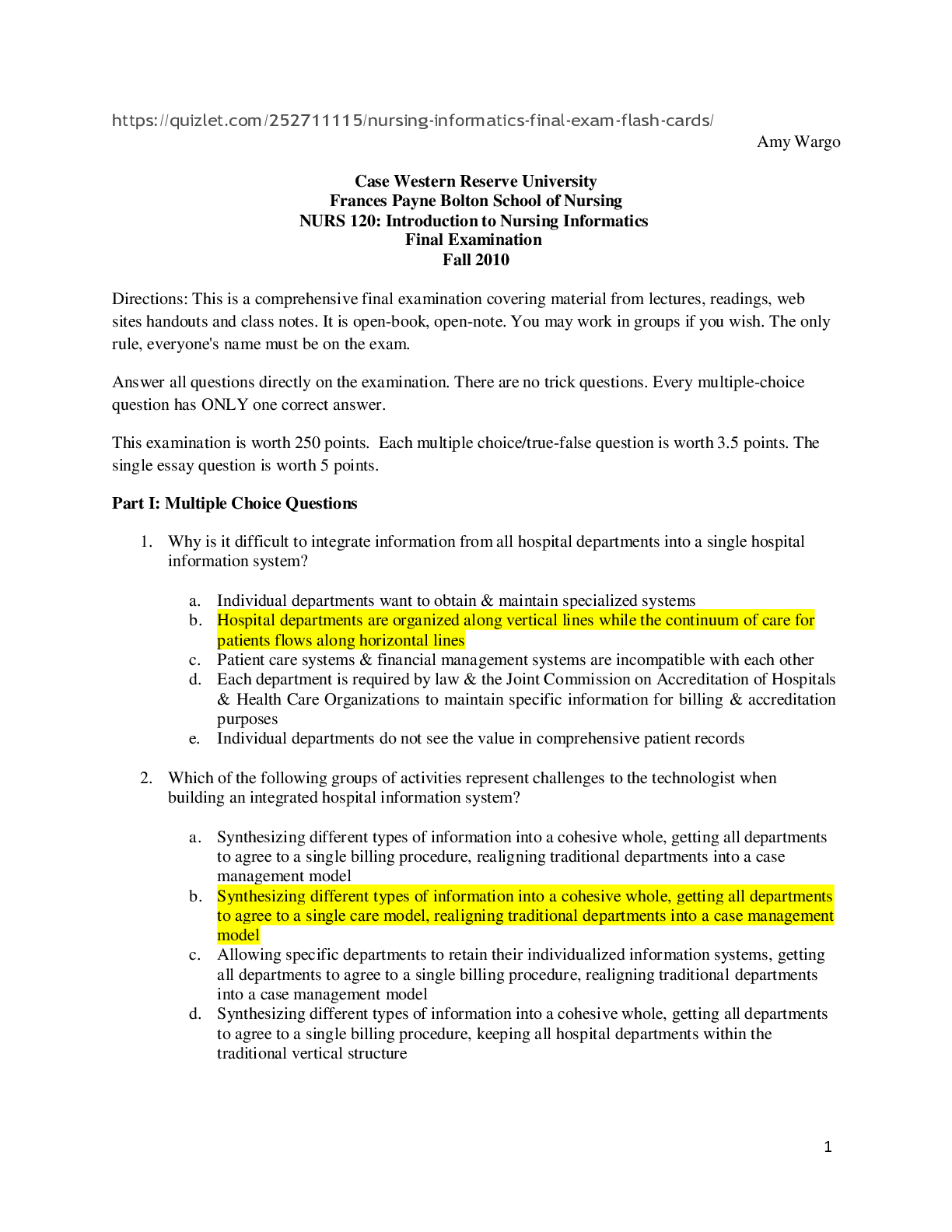
 – CHAMBERLAIN COLLEGE OF NURSING.png)
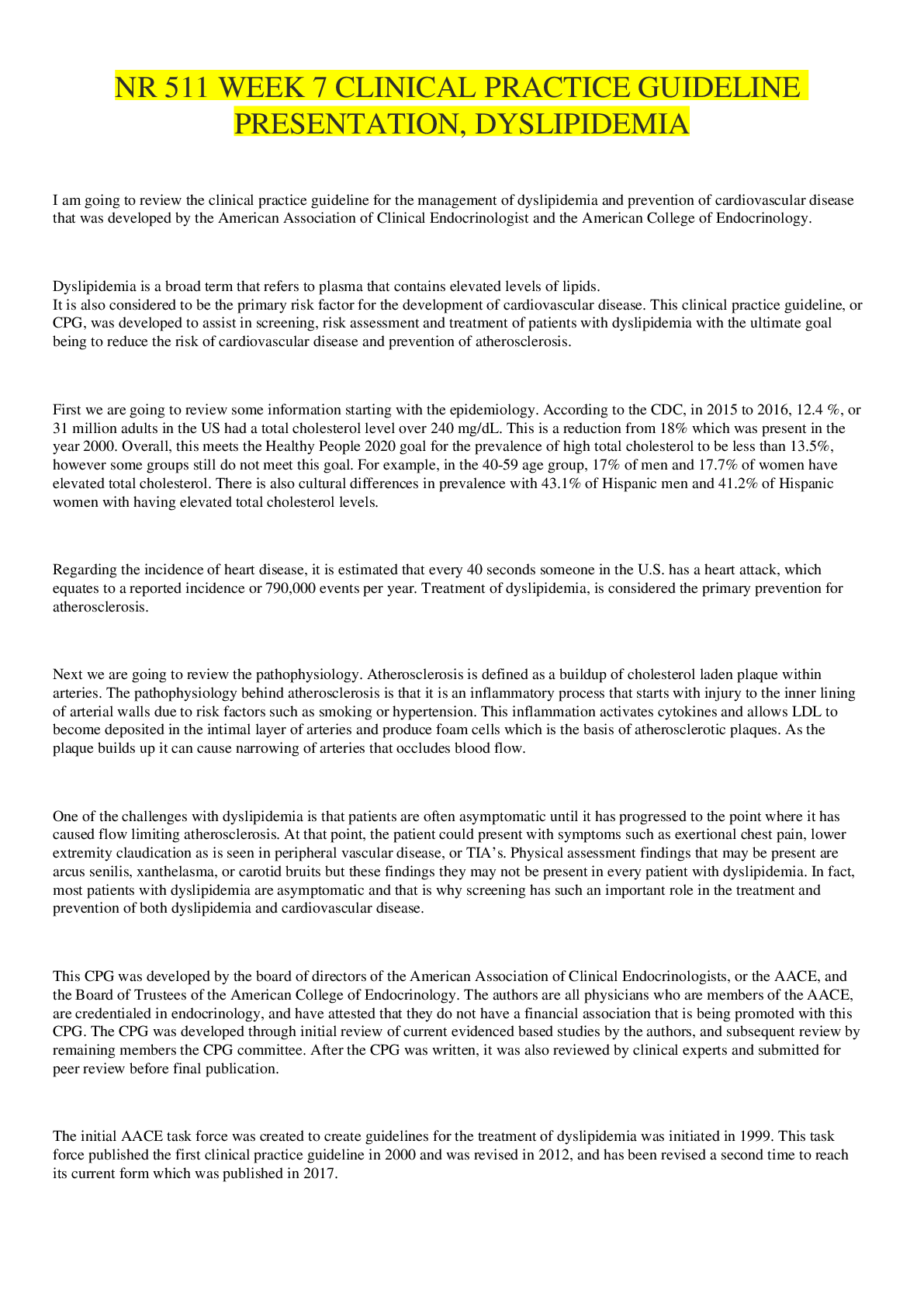
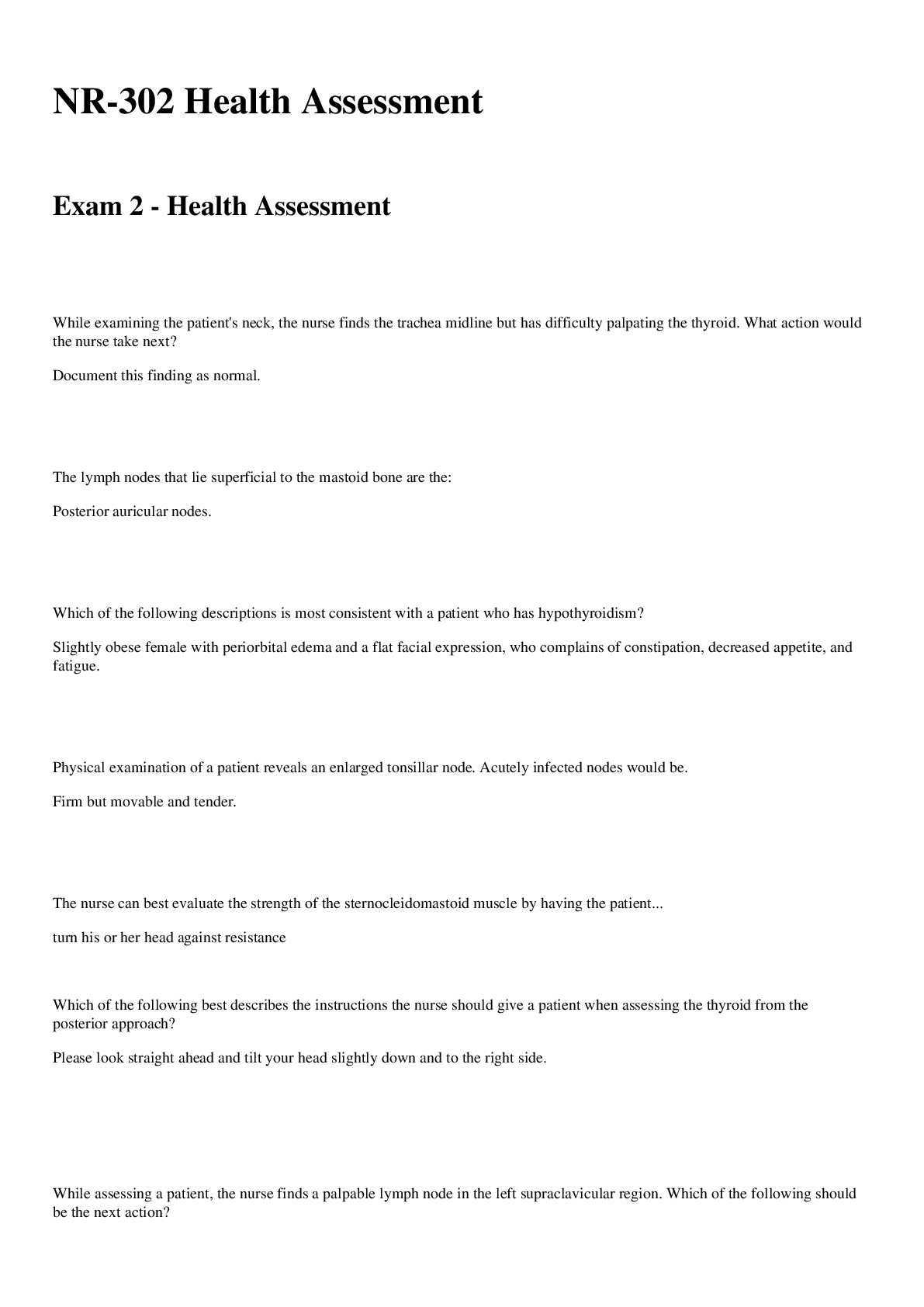
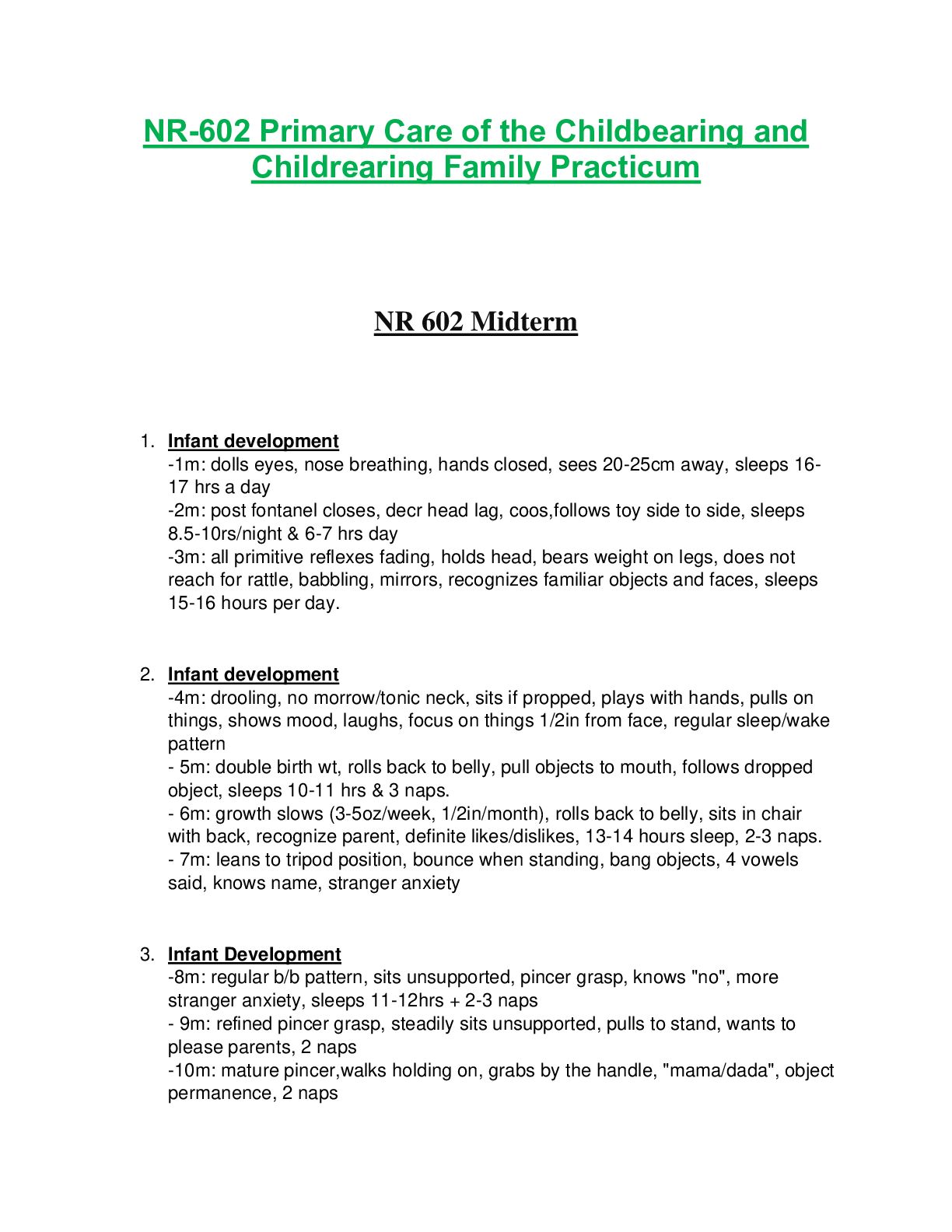
 – Chamberlain College of Nursing.png)

